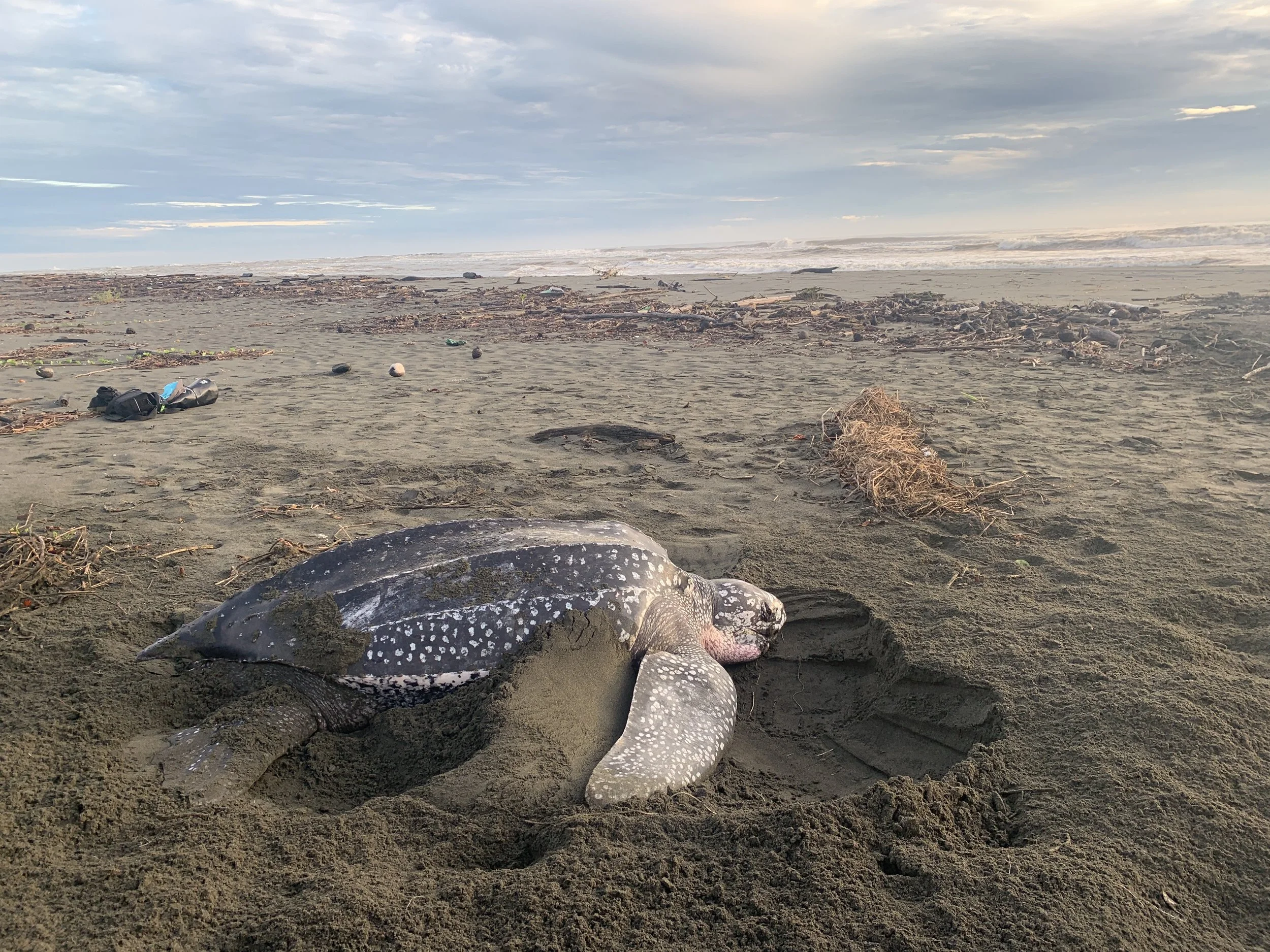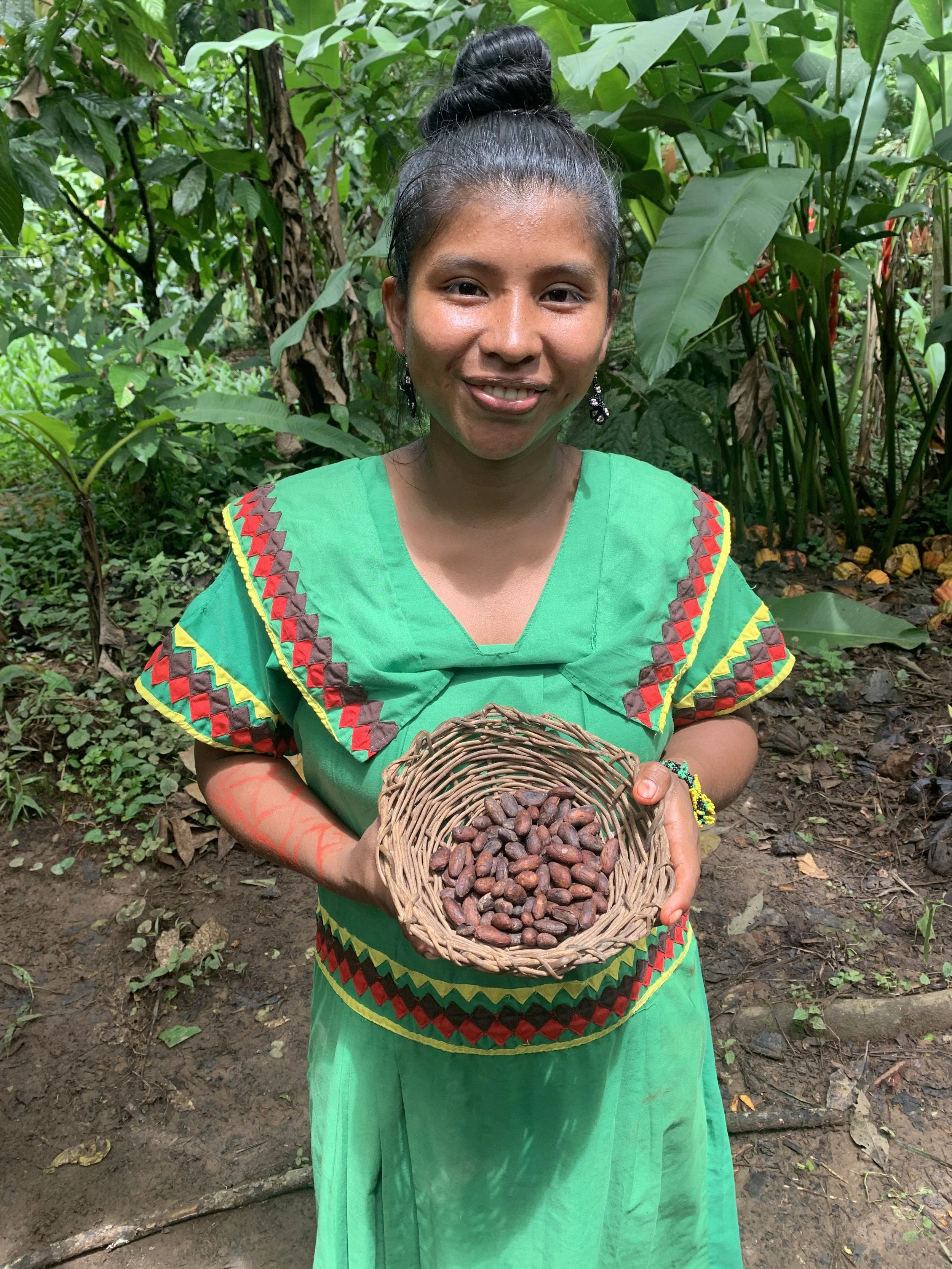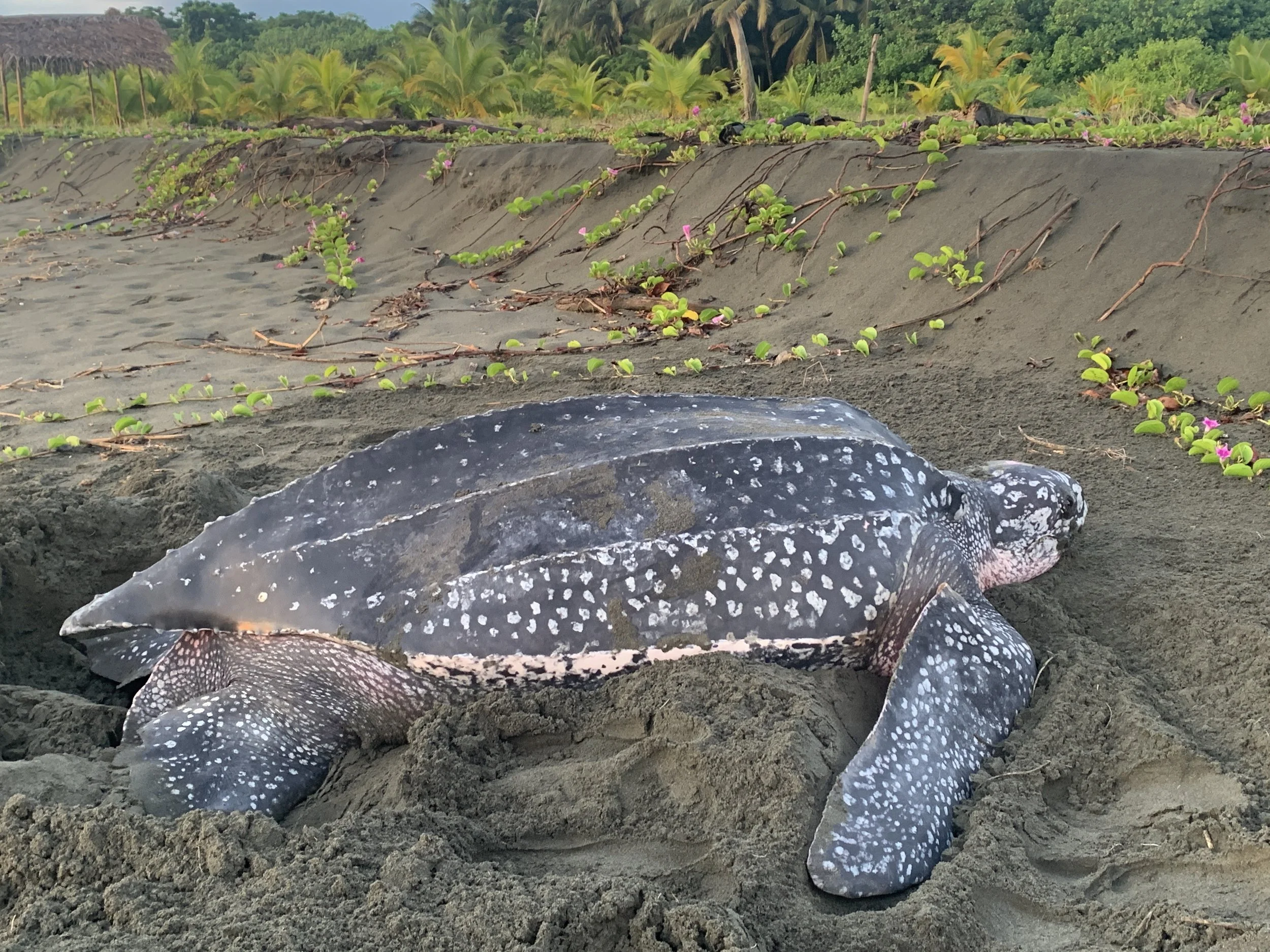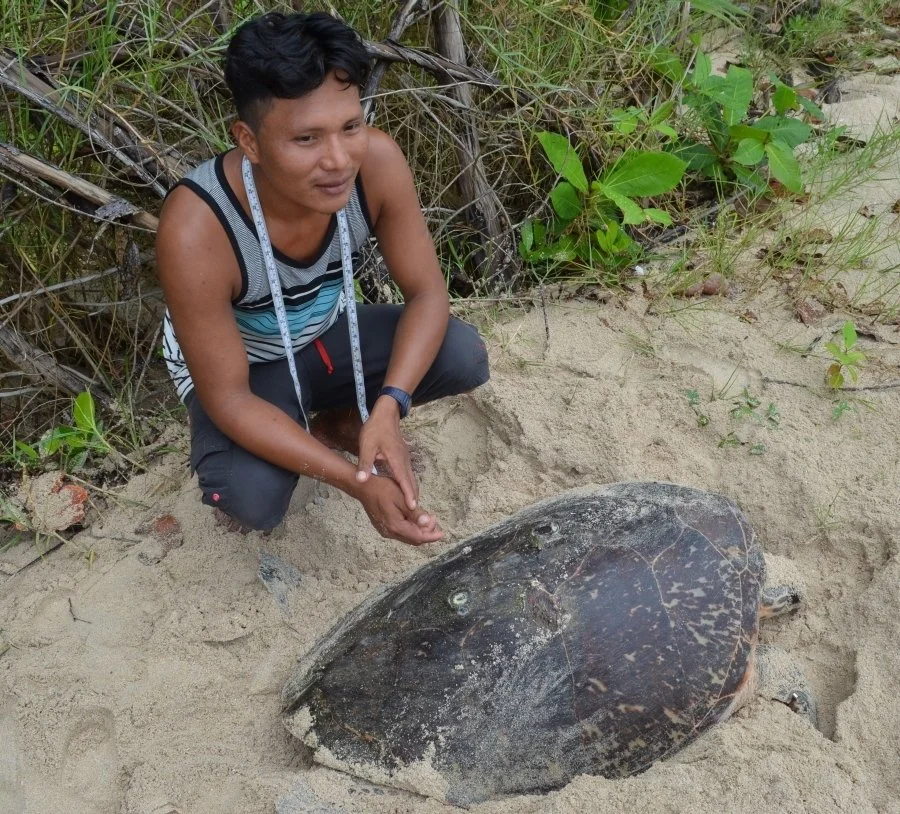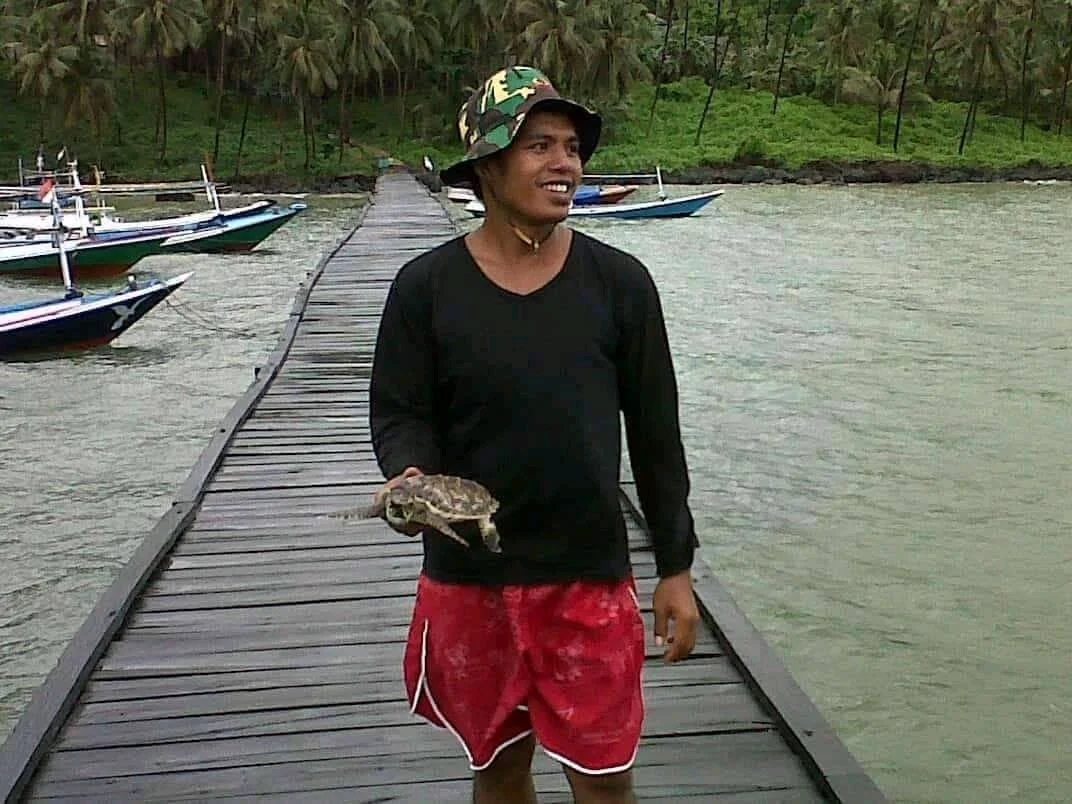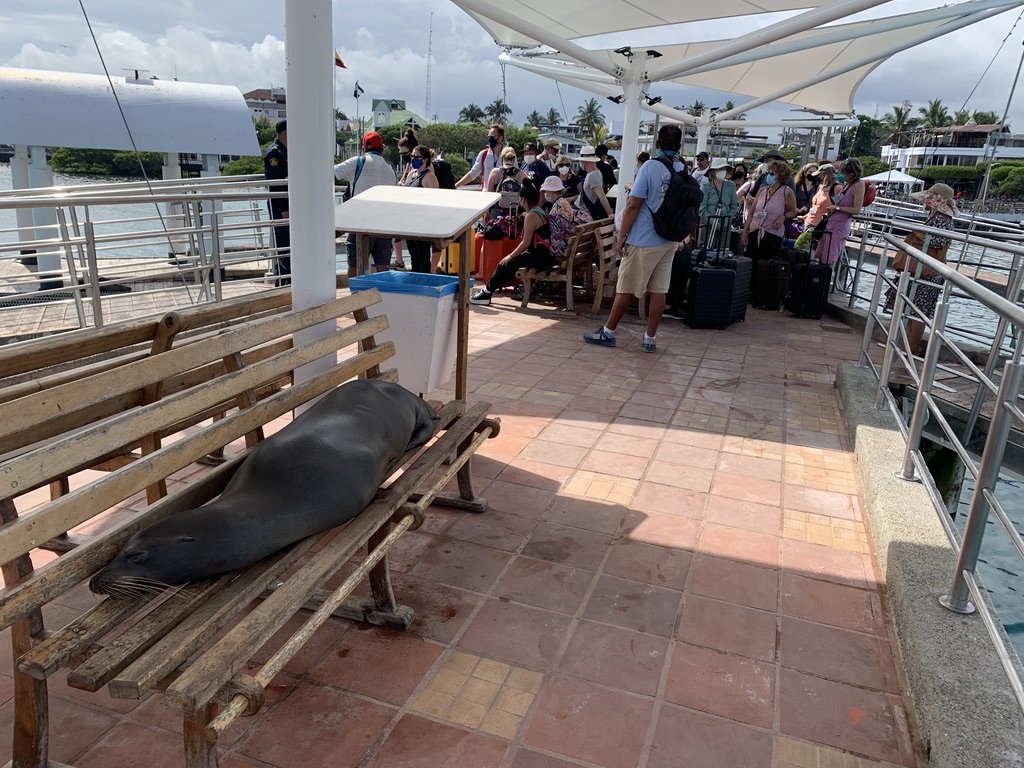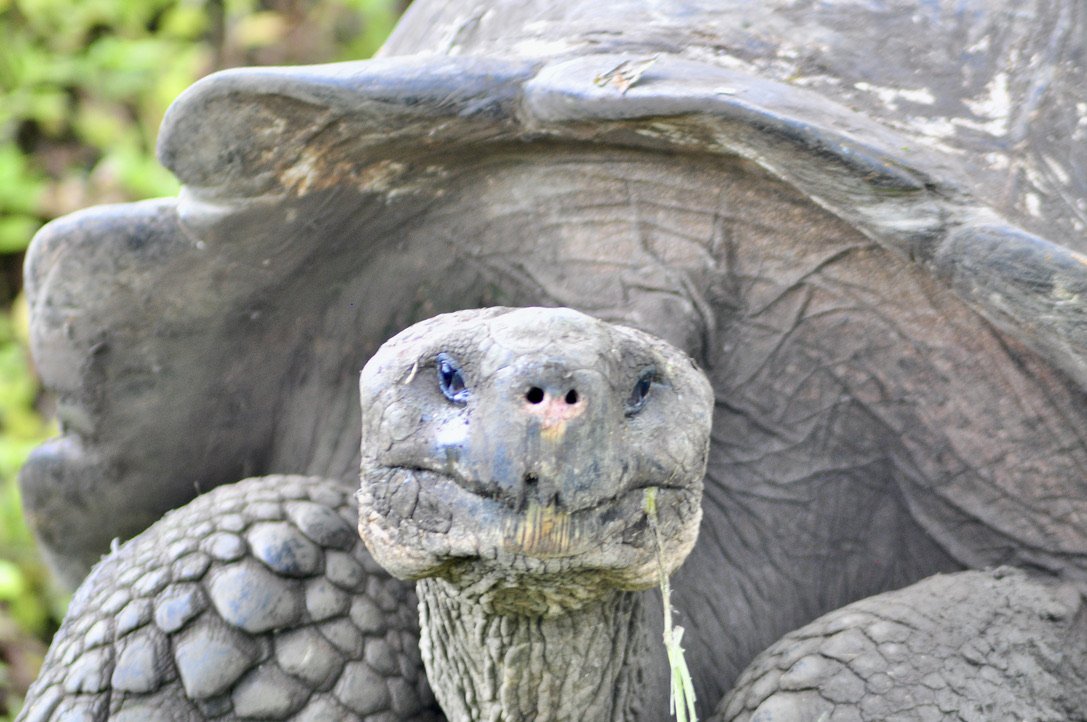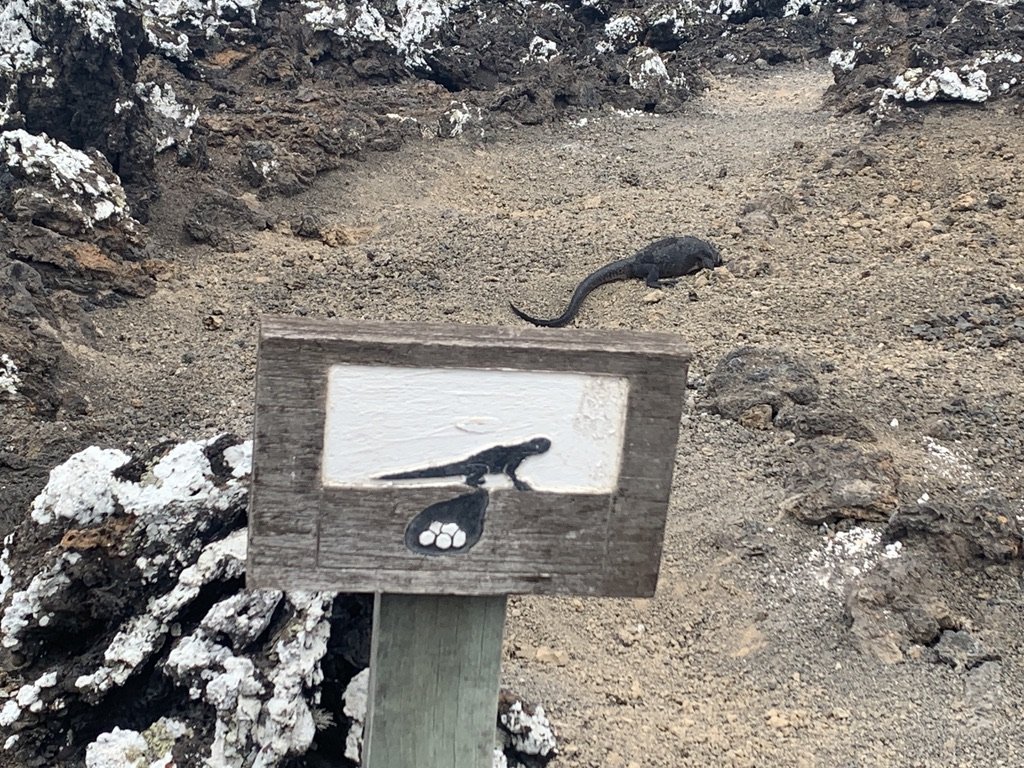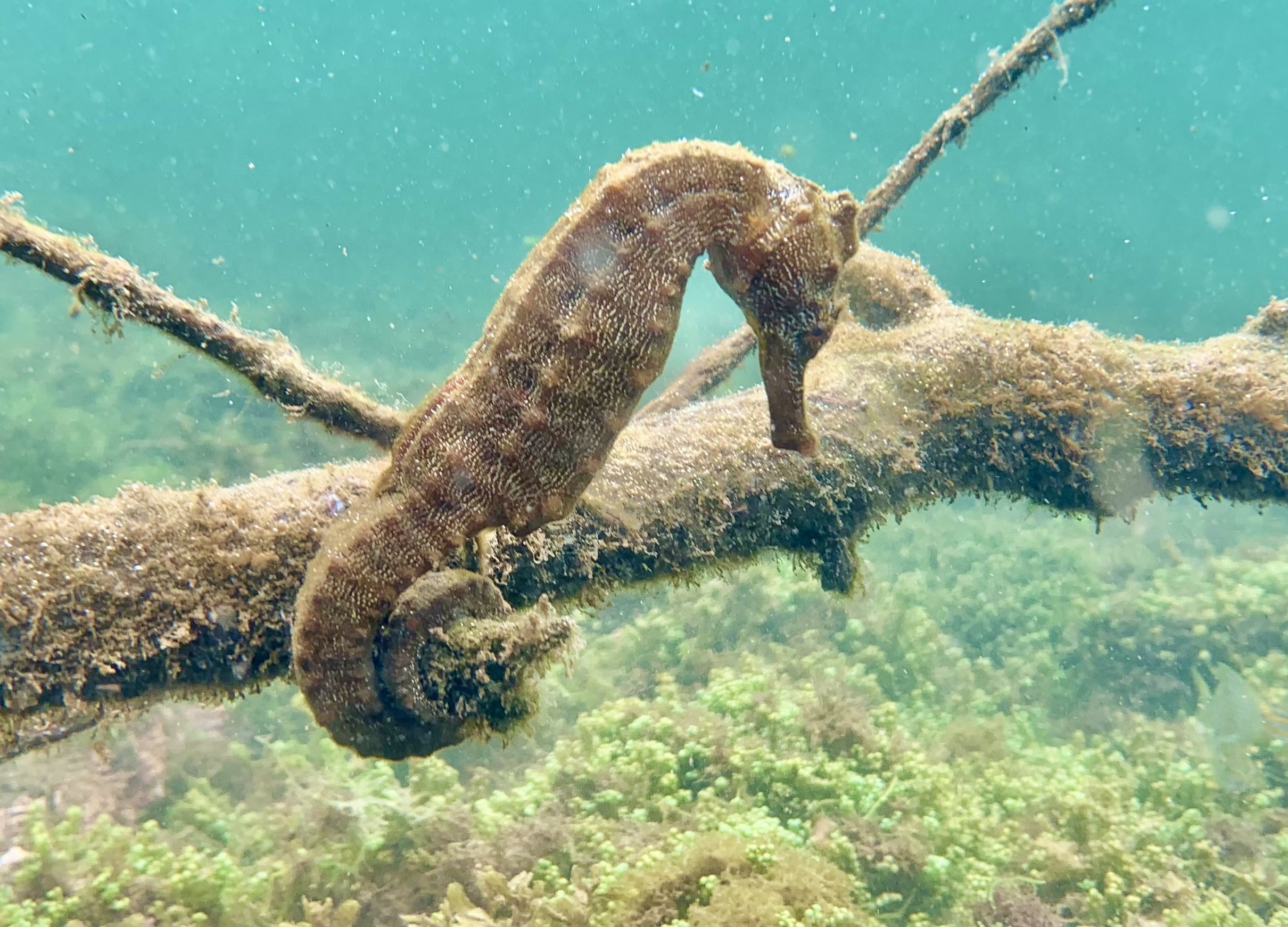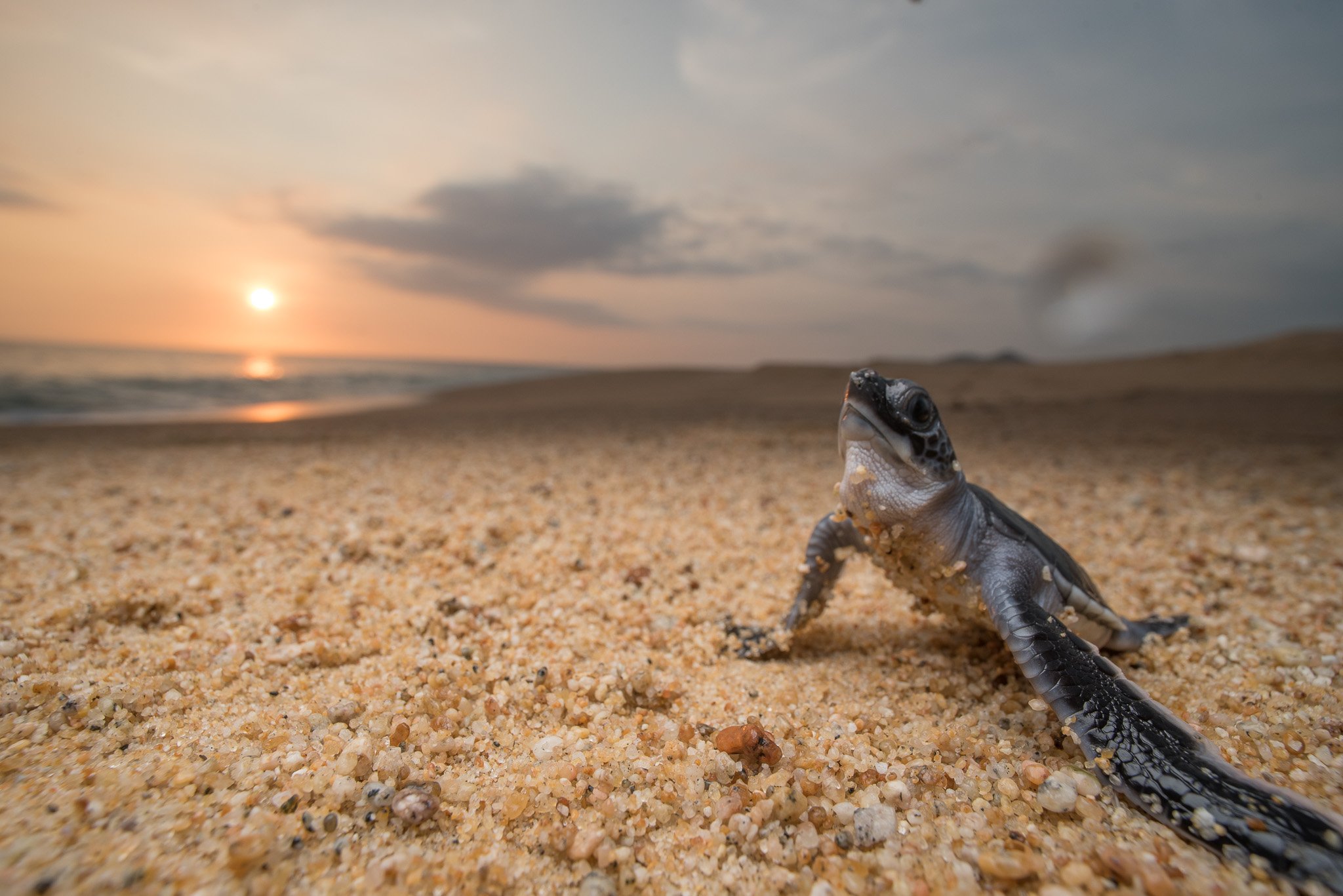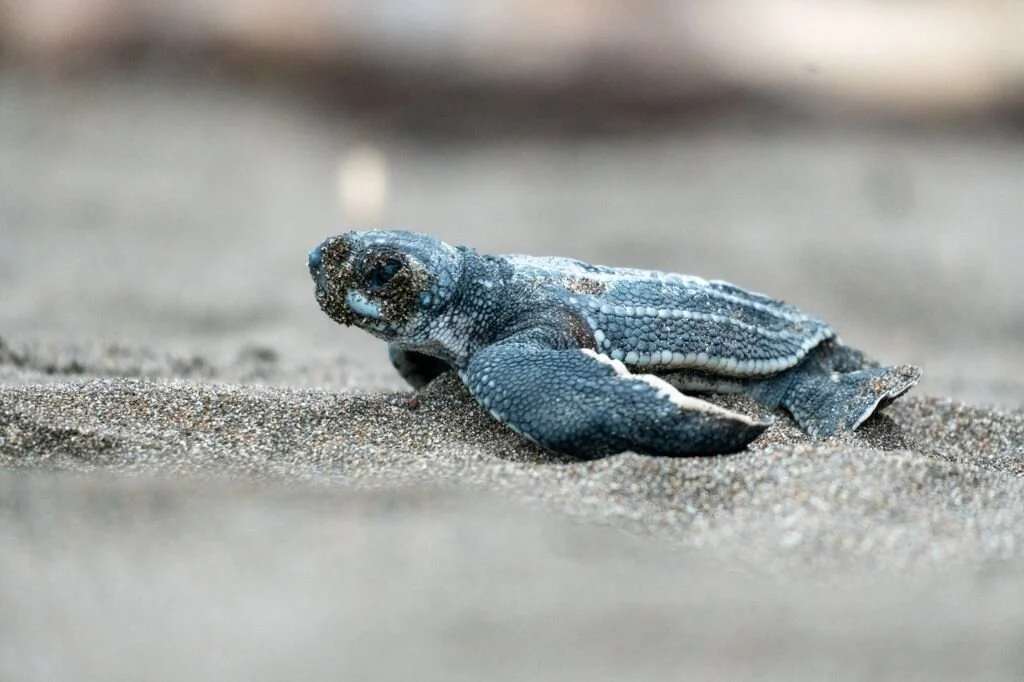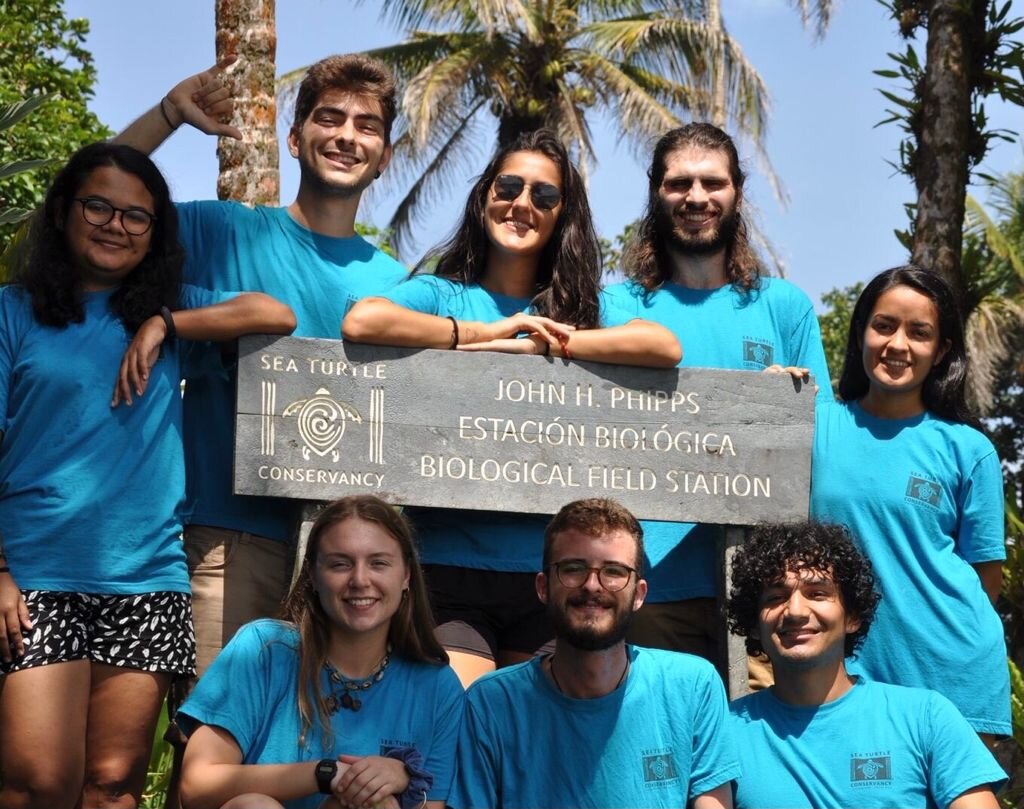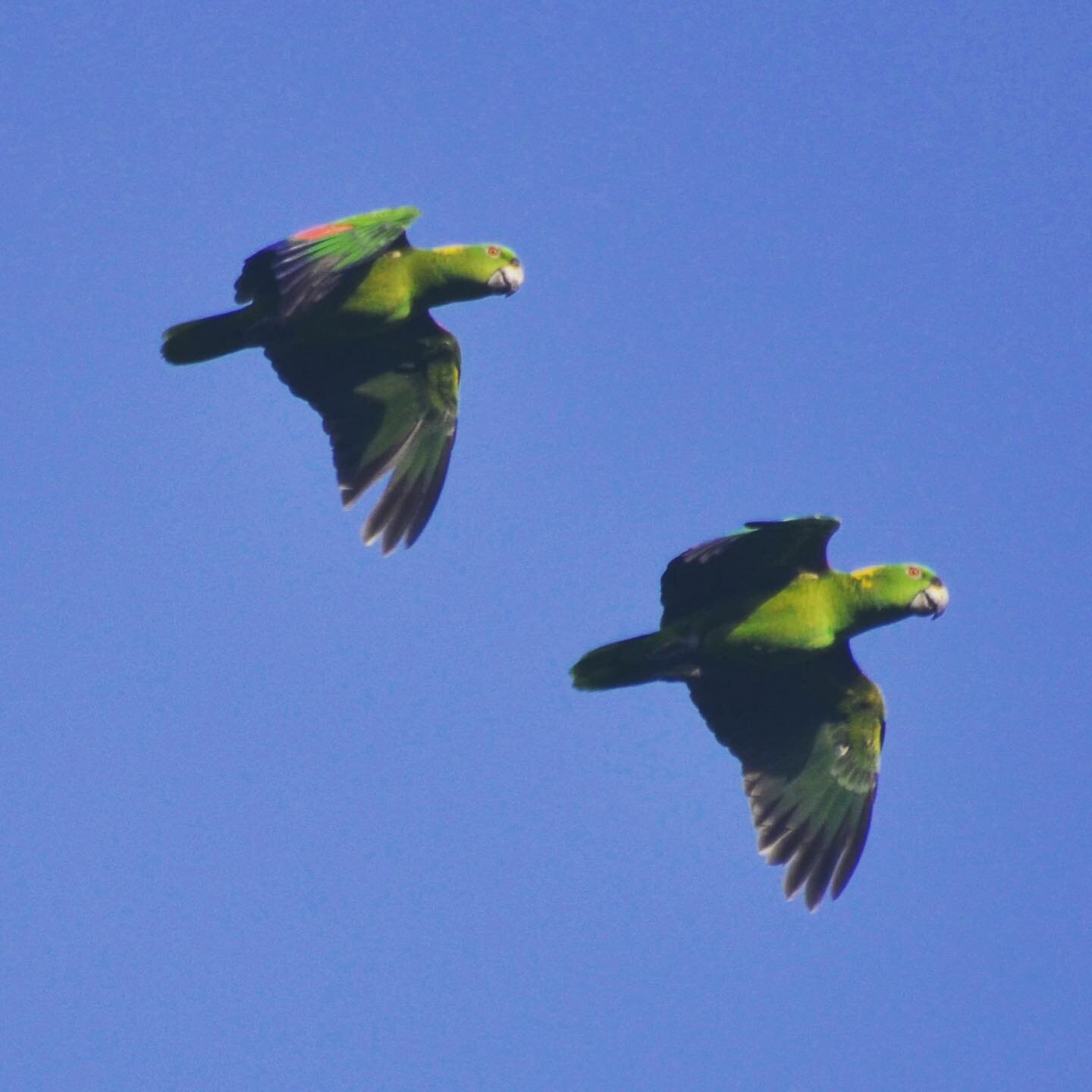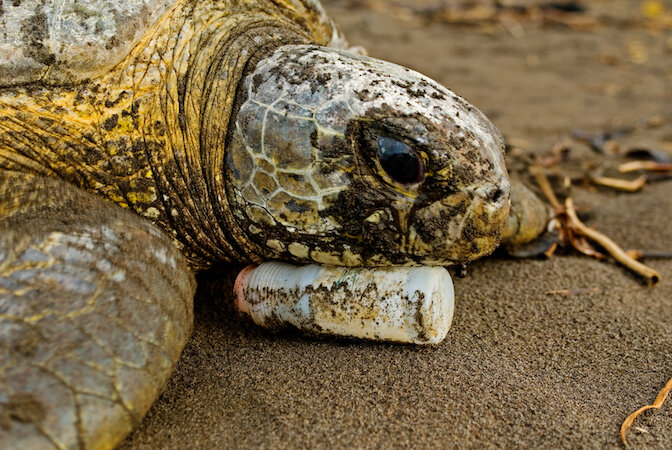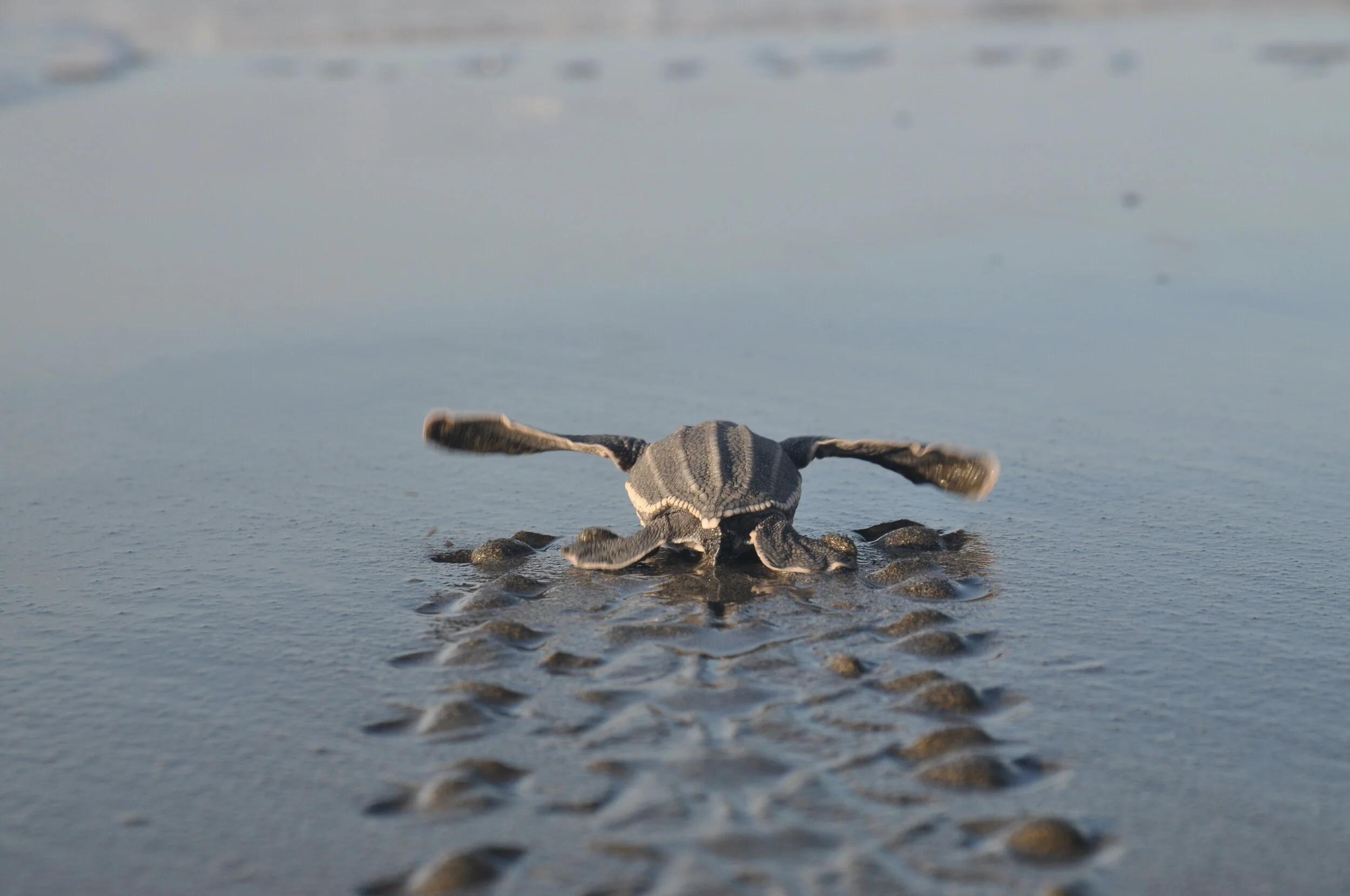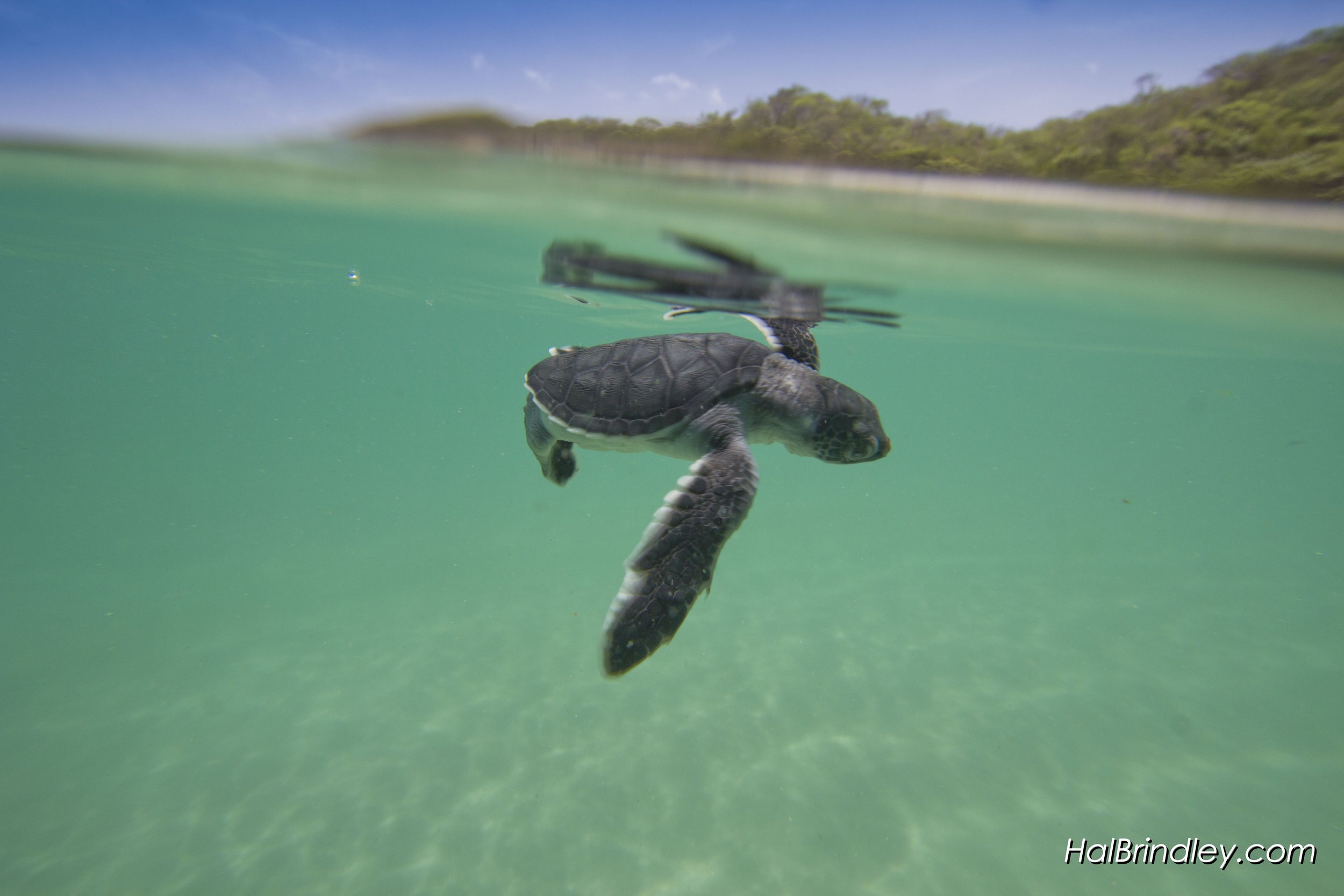
Turtle Blog
Inclusivity Fund Profile - Angelica Burgos
Note: Our Sea Turtle Inclusivity Fund provides financial support for young leaders from local communities near sea turtle habitats in developing countries around the world to advance their careers. This is a piece written by our most recent scholarship winner.
My name is Angelica Burgos. I am a Marine Biology student at the Universidad de Oriente Núcleo Nueva Esparta (Venezuela). From an early age, I have awakened an interest in animals and nature. I have been a collaborator of wildlife conservation programs on Isla de Margarita, and for years I belonged to the Scouts Association of Venezuela.
I haven't been able to continue with my plans because I have a chronic health situation, which, although not serious, has limited my opportunities. For me, this scholarship means an opportunity to continue my studies focused on marine life and conservation, and an impetus to start researching the threats facing sea turtles to generate possible solutions in the future. The Island of Margarita-Venezuela has great biodiversity and needs professionals who are dedicated to getting to know it to take care of it and conserve it. I want to be part of the solution and build a better world where the conservation of marine species is a priority.
With this inclusivity fund grant I have the opportunity to start a path towards sea turtle research, which will strengthen my training and will motivate me to generate real actions in the world of conservation.
Thanks to the SEE turtles Team for the great opportunity and to the MSc Marine Biologist Clemente Balladares for being a fundamental support for the procedures to obtain this scholarship, for his dedication, and for being the guide in this process.
Exploring Bocas del Toro, Panama
Our small plane eased gently out of the clouds to show the full archipelago of Bocas del Toro on a sunny June day. This area region on Panama, known for visitors from nearby Costa Rica, is truly an ecological gem. Composed of nine main islands, along with beautiful bays and ocean, mangrove cayes, and the northern Caribbean coastline, Bocas del Toro is home to a large part of the country’s indigenous population as well as native flora and fauna. After a quick stop for lunch in Bocas town, located on Isla Colon, we headed out by boat to the Soropta Field Station, along the mainland coast about an hour ride away.
Our group was here for our first Panama Leatherbacks & Hawksbill trip with our partners and friends at the Sea Turtle Conservancy. For five nights, we would be walking the turtle nesting beach and supporting the research and conservation work by our partners. We passed by a local family known for its illegal collection of turtle eggs, a stark reminder that much work remains to be done to protect these nesting turtles and their eggs. We arrived to the station in time for a release of leatherback hatchlings to the ocean, a wonderful introduction to the station.
That night we were treated to a rare experience; the Sea Turtle Conservancy staff were putting a satellite transmitter on a leatherback turtle, as part of their Tour de Turtles, a fun race between turtles in various spots around the Caribbean and Atlantic (follow this turtle CU-perina II here). While putting a transmitting on a leatherback is a bit more intensive than gluing a transmitter to the carapace of a hard-shell turtle, the information collected is critical to understanding the life cycle of these turtles. On our way back from witnessing this nesting turtle, our group encountered another and several of the group were able to help with the eggs to bring them to the hatchery, where they will be protected until hatching.
The next day, we had an introduction to the research being carried out at Soropta. This beach is one of the more important leatherback beaches in the Caribbean and has seen dramatic increases in nesting over the past few years. This season was a down one compared to a year ago, but still had more than 700 nests this season to date. STC staff are working on research to understand the composition of the sex of the leatherback hatchlings, as well as the health of this population. SEE Turtles, through our Billion Baby Turtles program, has been helping to fund the work at this beach since 2013, having provided more than $45,000 which has helped to save an estimated 60,000 leatherback hatchlings.
The next night, we headed out for another night of patrolling the beach. Shortly after the skies opened up, and the rain and wind kicked in, a turtle arrived. But members of our group got the full turtle experience, waiting until she nested and helped to bring the eggs to the hatchery just as the rain subsided. The next day, we headed to the Oreba Chocolate Tour, a wonderful activity run by the Ngobe indigenous community. Their fantastic guides showed us around their community, showing how the cacao is grown and processed, along with some of the plants and animals they use for sustenance and medicine. At the end of the trip, we were served a delicious traditional lunch and picked up chocolate and other crafts for souvenirs.
One day, our group collectively decided to get up for sunrise to see if there was a late nester that we might be able to see in the daylight. I was up a bit before the group and could see a beautiful sunrise forming over the water so I headed out to the beach to see if I could spot a turtle. I quickly noticed just a few meters from the entrance to the beach a dark spot of sand that was obviously a nest. Thinking we had missed a turtle right in front, as I started to walk over to inspect the nest, I noticed movement and realized the turtle was still there! I quickly ran back to the station to alert the group and back out to start taking photographs.
Nesting leatherback in Soropta. Photo: Brad Nahill / SEE Turtles
I spent several seasons working with leatherbacks in Costa Rica and have visited dozens of nesting beaches around the world but this was the best turtle experience I’ve had. Between the happy group, the beautiful sunrise, and witnessing the full nesting process in daylight, it was a morning I’ll never forget. Later that day, we headed out for a tour of the area’s canals, seeing many species of birds along the waters.
We wrapped up our tour visiting a couple of spots around the archipelago. The first stop was Starfish Beach, the most popular spots in the country, filling up with sunbathers every weekend. This area was visited by Christopher Columbus on his fourth visit to the hemisphere in the early 1500’s. Fortunately for us, we went on a Thursday when it was much more relaxed. We borrowed some snorkeling gear to check out the many sea stars around the clear waters, and relaxed with drinks by the beach. That night we had a free night to explore Bocas town, the main tourist area of the archipelago.
On our final full day, we did a full day tour of the islands, starting with looking for sloths along the water’s edge and bottlenose dolphins in the bays (we saw several of both). Later we headed to an area to snorkel and see some of the fish and coral species that live here. Finally, we ended with a picnic lunch on Zapatilla Caye, one of three islands in the Bastimentos National Marine Park where hawksbill turtles nest. While it was too early to see any hawksbills, we were able to take a walk through the island and snorkel in the crystal blue waters. SEE Turtles, through our partnership with the Berman Memorial Fund, has also been supporting the hawksbill nesting work of renowned researchers Annie & Peter Meylan, who have worked with community members for decades.
On our final night in Bocas, we met for a group dinner in a beautiful restaurant along the water. Unfortunately we had another taste of the reality of the situation for sea turtles in this area, witnessing two vendors who had tortoiseshell products for sale at tables along the main street. The good news for hawksbills is that since the end of the legal international trade, their numbers have grown significantly in this area and others, but the illegal trade continues to threaten this critically endangered species. Our Too Rare To Wear program is working to combat this trade (check out our SEE Shell App that can ID these products here) and we’re hopeful that hawksbills can recover over the long-term. With partners like Sea Turtle Conservancy leading the way, much progress is being made in Panama and around the world.
April Billion Baby Turtles Report
Past Grant Reports
Our Billion Baby Turtles program is on pace for a record year of saving sea turtles. Check out the results from grants from last year and our April grants from 2022!
Comunidad Protectora de Tortugas de Osa, Osa Peninsula, Costa Rica
This organization protects especially olive ridleys and green turtles and sporadically hawksbills and leatherbacks at 3 beaches (Playa Carate, Pejeperro, and Río Oro). This is one of the most biodiverse areas in Costa Rica. Since 2019 Tortugas de Osa monitoring and research projects offer the opportunity to involve different local actors, volunteers and conservation organizations, to contribute to the protection and monitoring of marine turtles.
During the 2021-2022 nesting season Billion Baby Turtles supported this project with US$ 10,000, helping to protect a total of 6,278 ridleys and 379 pacific green nesting females. The hatchling emergence for olive ridleys was 60% and 83.4% for green turtles. The estimated total production of baby turtles across all their 3 beaches for ridleys was 450,000 and 25,000 for the Pacific green turtles.
Olive ridley hatchlings from Costa Rica. Photo from COPROT.
Guanacaste Dry Forest Conservation Fund, Nancite, Costa Rica
Playa Nancite is the second most important nesting site for olive ridley sea turtles in Costa Rica. The arribadas of these turtles generally result in between 20,000 and 116,000 nests each year. Green turtles also nest at Nancite beach, but in much smaller numbers (between 20 and 65 nests per year). Turtle biologist Luis Fonseca has been studying the sea turtles of this area for more than a decade. His research covers the prey/predator phenomenon between nesting sea turtles and jaguar populations at Nancite beach, the first beach where such interactions have been extensively documented. With a US $3,000 grant, SEE Turtles supported Luis Fonseca research at this important beach.
In the 2021 season 68,230 nests of olive ridley turtles were protected, helping to get into the ocean 3,872,716 baby turtles. They also protected 26 nests of green turtles, helping 1,165 hatchlings of this species. With US$ 3,000 Billion Baby Turtles supported this beach for continue its work this year.
New Grants
Sea Turtle Conservancy, Panama (US $ 7,000)
After more than 20 years of sea turtle research in Bocas del Toro Province, Anne and Peter Meylan formed a partnership with STC in 2003 to monitor increasing nesting hawksbills along the Bocas coast (covering ~50 km of beach in recent years). The area of concentrated work by the Meylans has been three important nesting beaches: Small Zapatilla Cay, Big Zapatilla Cay (both since 2003), and Playa Larga (since 2006), all of which lie completely within the boundaries of the Bastimentos Island National Marine Park (BINMP). Research activities are conducted by beach monitors hired from local indigenous communities with help during most years from international student volunteers. In the last 8 years and thanks to the protection of the area, the number of hawksbill nests have doubled. In 2021, more than 140,000 hawksbill hatchlings are estimated to have been protected on BINMP beaches.
STC researcher Arcelio with a hawksbill turtle in Panama. Photo by Peter & Annie Meylan
Asociación Salvemos las Tortugas de Parismina (ASTOP), Costa Rica (US$ 3,000)
ASTOP protects the 6-km beach between the Parismina River and the Pearl Lagoon. This stretch is among the 10 most important beaches for nesting leatherbacks on the Costa Rica’s Caribbean coast. This organization protects more than 200 leatherback, more than 100 green turtles, and sporadic hawksbills that nests every year. In previous monitoring work, some season more than 20,000 hatchlings can be protected at this beach, with a calculated cost of 60 cents per baby turtle saved.
Ecosystem Impact Foundation, Indonesia (US$ 10,000)
This nonprofit organization works in Bangkaru Island protecting primarily green turtles and sporadic nesting leatherbacks. In addition to the protection of nesting turtles, Ecosystem Impact develops law enforcement capacity, campaign and advocacy work, community awareness, rangers training, and social media education.
Last season, Ecosystem Impact implemented for the first time a conservation program in this area, working with the community and rangers patrols. This work has led to the increased protection for these turtle nesting populations in the island, with a result in reduction of illegal collection. They also collected data on the project focus species which has fed into international research and conservation discussion. Due to concerns around turtle nests being lost to beach erosion and lizard predation, relocation of most at risk nests has been implemented and they are also working in further mitigation and research for these populations. With US$ 10,000 they expect to protect around 62,500 baby turtles for this season
Ocean Foundation: Guanahacabibes National Park, Cuba (US$ 5,000)
Since 1998, the Ocean Foundation’s Cuba Marine Research and Conservation Program (CMRC) has built strong scientific collaboration and conservation programs between Cuba, the United States, and neighboring countries that share marine resources. Eight beaches are patrolled during the nesting and hatchling seasons (May to October) on the Guanahacabibes Peninsula. As for green turtle nesting population, it is the second largest of the Cuban archipelago and also exhibits high levels of hatching success.
The main goals of this project are to monitor and protect nesting areas, record morphometric, nests and eggs information, study, temperature and humidity to determine the best conditions, expand studies on existing genetic diversity for this area, assess the impact of climate change on the reproductive success of sea turtles, train university students and volunteers, and develop educational work in local communities. With this grant, Billion Baby Turtles will help to protect around 35,000 baby turtles in this area.
Green turtle nesting in Guanahacabibes. Photo from Dr. Julia Azanza.
Sea Turtle Inclusivity Fund
PAMALI, Indonesia
SEE Turtles launched our Sea Turtle inclusivity Fund in 2021 as a way to increase inclusion, diversity, and local community participation in our field. Our first three winners were from Latin America, Keithlyn Rankin of Costa Rica, Luna Viera of Brazil, and Royner Carrasquero of Venezuela. We’re excited to announce our first winner from Asia, Busdar Marabatuan from PAMaLi Indonesia.
With a grant of US $2,517, the Inclusivity Fund will cover Busdar’s salary for a year in the position of Ranger Coordinator, where he will be responsible for 4 Rangers. “My career goal in the position of Ranger Coordinator is to contribute to the development and progress of turtle conservation and strive to be an investment by creating a dynamic and innovative work environment.” -Busdar
Busdar with a juvenile hawksbill turtle in Indonesia. Photo: PAMaLi.
Meet our newest Inclusivity Fund Winner, Busdar Marabatuan
SEE Turtles launched our Sea Turtle inclusivity Fund in 2021 as a way to increase inclusion, diversity, and local community participation in our field. Our first three winners were from Latin America, Keithlyn Rankin of Costa Rica, Luna Viera of Brazil, and Royner Carrasquero of Venezuela. We’re excited to announce our first winner from Asia, Busdar Marabatuan from PAMaLi Indonesia. We wanted to share an introduction provided by him below.
My name is Busdar, I love sea turtles. I was born to parents who are very close to the coast and the sea. I was born on a remote island in Indonesia, namely Marabatuan Island, Pulau Sembilan District, Kotabaru Regency, South Kalimantan Province. My education from elementary school to junior high school was completed on Marabatuan Island, but for high school I was forced to migrate to the district capital because at that time there was no high school on the island.
My familiarity and familiarity with the coast and the sea formed my character. I am a lover of biological natural resources and their ecosystems such as the presence of turtles on the surrounding islands. I am really very concerned about the level of threat to the turtle population, which has decreased drastically over time, mainly due to the impact of illegal hunting and habitat destruction.
Over time, my growing concern for the sustainability of turtles on Pulau Sembilan prompted me to approach and join friends who at that time were not yet a PAMaLi association but were just a youth community who longed for turtle conservation through turtle conservation activities. For about 10 years, together with friends in the youth community who care about turtles, they have voiced concerns about the fate of turtles, which at that time trading in eggs and a small portion of meat and scales was still very widespread and open even though the government of the Republic of Indonesia had actually banned it through the laws and regulations of the Republic of Indonesia. In 2015, I determined to deepen my knowledge and insight in the field of wildlife conservation by accepting a vacancy as a volunteer at PROFAUNA Indonesia, a local organization based on the island of Java, precisely in Malang City, East Java. There I gained a lot of knowledge and insight related to wildlife and forests, and had an internship as a Ranger in the Wehea Forest, East Kalimantan, Indonesia.
The climax was at the 2015 Saijaan Expo, an exhibition event at the Regency level that showcased local products from every sub-district on Pulau Sembilan. At that time, the Pulau Sembilan stand also offered turtle eggs to be sold in a pack of 10 seeds for Rp. 50.000. We, along with the youth community who care about turtles (the forerunner of Pamali Indonesia) contacted local journalists to cover the state of the Pulau Sembilan stand. Sure enough, the Pulau Sembilan stand still offered the protected turtle eggs for sale. And when the news was brought up to the television media, it immediately provoked a reaction from the Minister of Maritime Affairs and Fisheries who was then held by Mrs. Susi Pudjiastuti.
After a few days, Mrs. Susi Pudjiastuti, the Minister, issued a circular addressed to Regional Heads, Governors, Mayors, and Regents to pay attention to the protection of turtles and their habitats in Indonesia. The Minister also ordered a work unit at the Ministry of Maritime Affairs and Fisheries to go down to the field to inspect the Saijaan Expo exhibition arena. As a follow-up to the findings of the incident, the central government of the Republic of Indonesia through the Ministry of Maritime Affairs and Fisheries held a National Action Plan (RAN) program for Turtles from 2016-2019 and I decided to return and join the National Action Plan for Turtle KKP RI as one of the Enumerators for Turtle Conservation in the period 2016-2018. Over the next 2 years, he went back to deepen his knowledge and insight in the field of turtle protection and conservation by joining as a Turtle Conservation Ranger in the turtle conservation program on the islands of Bilang Angka, Balembangan, and Sambit with the Indonesian Turtle Foundation in the period 2019-2021. (Note, SEE Turtles Billion Baby Turtles program has been supporting the work on Sambit Island as well.)
That's a bit of my life's journey, especially those related to my life which intersects with the issue of wildlife conservation and their habitat, especially turtles. I want to continue to learn new things about the issue of turtle conservation in the hope that I can continue to explore things that are relevant to my career and passion so that I have more knowledge and insights that develop so that I can make a positive contribution to turtle conservation, both in the short term and in the long term. I believe that one day I can reach a senior position with experience in the field of turtle conservation and then we can share knowledge and insights about turtle conservation with junior turtle conservation activists now and in the future.
In that period of time, both what I have traveled and what I will take will not be short and easy, but will be full of challenges. However, I will continue to adapt, establish relationships, and expand my network to turtle conservation activists, either nationally, regionally or internationally. At the same time, he remains active and productive in his activities in the field of turtle conservation that he is engaged in. My career goal in the position of Ranger Coordinator is to contribute to the development and progress of turtle conservation and strive to be an investment by creating a dynamic and innovative work environment.
The career I chose as Ranger Coordinator is closely related to my work experience, so I will try my best to make a positive contribution to turtle conservation. For me, applying for a job involved in the issue of turtle conservation is very interesting, especially since I can learn by doing. It is certain that this will be a very valuable experience for enriching my knowledge and broadening my horizons on the issue of turtle conservation. Next, I will use my passion and talent in working for the sake of changing the knowledge, views, actions of people around us, both in Indonesia and in the world, especially on Pulau Sembilan which is the most important turtle habitat in South Kalimantan. Finally, let's think locally and act globally. The welfare of the turtle is a mandate from God which is entrusted to his trusted creatures, yes we, humans.
Billion Baby Turtles Feb / March 2022 Update
We’re excited to start a new regular series of updates for our Billion Baby Turtles and Sea Turtles & Plastic programs. Check back early each month to read about results from our partner grants and new grants to help save sea turtles around the world!
February 2022 Billion Baby Turtles Reports:
Sea Turtle Conservancy: Soropta Beach ,Panama
STC protects leatherback and sporadic hawksbill and green turtles at this beach in the northern Caribbean. During the 2021 season (from March 1 to August 17) SCT recorded 1,484 leatherback nests on Soropta Beach, which is the highest nest count recorded here since the beginning of this program. They did 1033 hours of night patrols, recording 647 encounters with leatherbacks. The total hatchling production at Soropta Beach in 2021 was 19,569 (18,412 leatherbacks and 1,155 hawksbills).
Funding from Billion Baby Turtles was used to cover the expenses involved in implementing monitoring and protection activities throughout 2021, including salaries, food and housing costs for project staff; purchase field equipment, such as flipper tags, headlights and data books; and gas for the project boat, which was needed to transport staff and supplies to/from the field station. With US $4,000 SEE Turtles helped to protect 350 nests and almost 5,000 hatchlings with a cost of 81 cents each baby turtle.
Leatherback hatchling from Soropta
Soropta Field Station
Latin America Sea Turtles- LAST: Cahuita Beach & Pacuare Beaches, Costa Rica
Since 2000 ANAI and LAST non-profit organizations have worked made uninterrupted efforts for the protection and conservation of nesting females and baby sea turtles in Cahuita Beach. During the last decade it was estimated that 90% of the nests at this beach were lost by wildlife predation, illegal egg collectors, poachers or washed out by the ocean. Cahuita’s nest population represents one of the highest numbers reported for Caribbean hawksbill turtles in Costa RicaCR. Thus the importance of the protection of this beach. In 2021, SEE Turtles supported this project with US $4,500 USD. During this season the project recovered 32 nests of hawksbill and one of green turtle, with a total of 4,943 eggs. After the incubation period they released a total of 3,645 baby turtles with a success rate of 73,74%. All of the hatchlings baby turtles were released to the ocean in front of Puerto Vargas area at Cahuita National Park (CNP).
At Pacuare Beach, From February to July 2021 LAST monitored and protected lLeatherback nests in Pacuare. In this region, the illegal egg collection, still continues as a common practice;, just this season 34% of the total nests were collected (76). In the 2021 season, SEE Turtles supported the Pacuare project with US$ 5,000. During this period, 224 nests were protected, either moving them to the hatchery or relocating them to safer areas. They had a success rate of 78% and they released a total of 9,704 leatherback baby turtles.
Grupo Ecologista Quelonios, Punta Xen, Mexico
Since 1992 Quelonios established a program for the protection and preservation of hawksbill turtles in Punta Xen, covering 30 kilometers of beaches in the coastal zone of Champotón. This is one of the most important beaches for this critically endangered species in Mexico. For the 2021 season, they protected a total of 1,783 nests and 238,963 eggs with a hatching success of 73% with a total of 173,495 hatchlings. With US$ 4,000, Billion Baby Turtles supported Quelonios to protect 80 nests and almost 8,000 baby turtles to get to the ocean.
Quelonios Hatchery
Hawksbill hatchling from Quelonios
ProCosta, Bahía de Jiquilisco, El Salvador
ProCosta has been working in Bahía de Jiquilisco since 2008 protecting nesting hawksbills. Prior to the establishment of the project, 100% of the nests and even some adult turtles were illegally collected and locals were unaware of the importance of their communities for this species. This project brings monitoring to the beach, nests protection and social outreach for local communities. During the 2021 season the project staff and local hawksbill conservation networks monitored 42 km of nesting beaches for 300 days. There were 310 nests during the whole season, and 308 were protected, with a hatching success of 53%. These efforts helped 24,949 baby turtles to get to the ocean. There were also 200 local families involved and benefited from this program. Billion Baby Turtles supported this project with US$ 5,000.
March 2022 Billion Baby Turtles Grant Reports
Barbados Sea Turtle Project: Barbados)
This program protects primarily especially hawksbills but also some leatherbacks and green turtles. For more than 25 years, this project has been involved in conservation of sea turtles that nest on Barbados through research, education, and public outreach as well as monitoring of nesting females, juveniles and hatchlings. SEE Turtles has supported this project since 2020. The total number of hawksbills recorded nesting in the 2021 nesting season (June to November) was 494. With a grant of US $3,000, SEE Turtles helped to protect 90 nests and 10,831 baby turtles, with a cost of 27 cents per hatchling saved. The project had an estimated more than 237,000 total hatchlings for the 2021 season.
Reef Guardians: Lankayan Island, Malaysia (Reef Guardians)
Since 2004, this project has protected hawksbill and green turtles nesting on Lankayan Island, in Malaysia. Since then, the annual nesting increased gradually from 138 nests in 2004 to 833 2021. This year they protected 726 nests of greens and 107 nests of hawksbill turtles. In 2021, the organization recorded the 2nd highest total for the last 21 years. A total of 74,506 eggs were incubated for both species with a total of 59,863 hatchlings helped to get to the sea. With US $2,000, Billion Baby Turtles supported the protection of 60 nests and 4,000 baby turtles.
Ocean Foundation: Cuba, Guanahacabibes National Park, Cuba
Since 1998 the Ocean Foundation’s Cuba Marine Research and Conservation Program (CMRC) has built strong scientific collaboration and conservation programs between Cuba, the United States, and neighboring countries that share marine resources. Eight beaches are patrolled during the nesting and hatchling seasons (May to October) in Guanahacabibes Peninsula. As for green turtle nesting population, it is the second largest of the Cuban archipelago and also exhibits high levels of hatching success. During the 2021 season they registered 685 nests of gGreen turtles and 2 of hHawksbills and reported a very high hatchling success with 910.84%. However, many nests were lost due to environmental conditions. During this season SEE Turtles supported this organization with US $3,500, helping approximately 25,000 baby turtles to get to the ocean.
March 2022 New Billion Baby Turtles & Plastic Grants
Karumbé: La Coronilla, Uruguay
#Plastic Free Turtles will organize collaborative beach cleaning actions with the participation of coastal communities and local organizations of La Coronilla and Punta del Diablo (Rocha, Uruguay) for the removal of plastic waste in coastal-maritime habitats in the area. These activities will be supported by the creation of environmental awareness and the empowerment of communities towards a circular and more sustainable economy. In addition, a systematic monitoring of the abundance and trend of aggregation of plastics within the Cerro Verde Marine Protected Area will be implemented through the removal of plastic waste by the Karumbé team, along with the management and treatment of plastic waste originating in the organization's base camp.
Once classified and cleaned, all of the collected waste will be transported for subsequent recycling by the company Plasticoin-Uruguay generating a virtual currency in exchange for the total weight of waste delivered. This virtual currency will be reinvested in veterinary products and other supplies for the rehabilitation of sea turtles with problems of plastic intake (and other pathologies) in the rescue and rehabilitation center of Karumbé.
Karumbe volunteers cleaning the beach in Uruguay
PROVITA: Paria Gulf, Venezuela
Near the estuary of the Orinoco River delta and the Paria Mountains National Park in Venezuela are several small beaches where leatherback and hawksbills sea turtle nests each year. The region in the early 2000’s century and before had a strong hunting pressure; the conservation project reduced that from 88% (in 2003) to 1% (2015) but since 2016 a lack of funds and habitat destruction has restarted the impact on the marine reptiles. This project’s goal for 2022 is to rescue a hundred nests, gather all the reproductive data from 5 main nesting beaches, and deter hunting through patrolling and transplanting nests to a secure hatchery in the town of Macuro.
Ayotlcalli, the Little Turtle Group That Could
There are many reasons that a turtle conservation organization like Ayotlcalli should not exist. The group was started by a school teacher, Damaris Marin-Smith and her husband Gene Smith who had no experience with sea turtles and no experience with running a nonprofit. Heck, she was afraid of the ocean and didn’t like sand or mosquitoes, let alone saw herself leading an effort to protect an ocean creature! But there she is, inspiring her community to protect turtles and their nests, educating kids, and showing the older and better funded organizations how it should be done. Ayotlcalli has succeeded over the past decade with minimal financial support but a boatload of passion and enthusiasm.
Olive ridley hatchling released by Ayotlcalli
Walking around the communities of Barra de Potosi, Zihuatanejo, and Ixtapa with Damaris is like being in the entourage of a celebrity. People’s faces light up when she arrives and everyone wants a hug. It is difficult to go more than 30 minutes around this area with her and not meet one of her many volunteers.
Ayotlcalli, which means “Place of the Turtle” in the indigenous Nahua language, began in 2011 when Damaris was visiting family in Zihuatanejo. An ecologist friend who lived there told her about the sea turtles nesting in this area and the problems they were facing including people eating turtles and their eggs, as well as feral dogs. In the evening, the friend took Damaris out to the beach to see a nest of hatchlings that a community member had saved and was releasing and later she saw a nesting turtle. The tears that flowed from the turtles eyes while expelling the salt water caused Damaris to tear up herself, and from there she was hooked.
Photo: Bridget Fahey
Damaris and Leo, a donor and member of Ayotlcalli
In the first years of the project, Damaris and Gene played the role of international donors, funding the construction of a hatchery and supporting the effort out of her pocket from her home in Houston, Texas. That first nesting season, the work started late and only found a couple of nests, but they kept working at it, and the following season they had much more success. However, by the third year of the project, her friend decided to move and Damaris was going to close the project. But some of the volunteers working there at the time convinced her to keep going and helped to manage the project over the next few seasons.
Her reach goes well beyond the turtles nesting on the three beaches where Ayotlcalli works; her popular camps attract kids both wealthy and not wealthy, for two weeks of learning about the natural world. From hands on work with the turtles, to cleaning the beaches, observing whales, visiting local wildlife refuges, and more, Damaris puts her teaching skills to work. The kids learn leadership and build social skills while gaining an appreciation for wildlife and their extraordinary community. (SEE Turtles has provided financial support for the camp.)
In 2017, Damaris retired from teaching in Houston and instead of relaxing or traveling the world, she and Gene began to manage the organization directly. She threw herself into learning about these animals and how to best protect them. She attended conferences and symposia to build her knowledge, meeting experts like Dr. Andy Coleman, Assistant Professor of Biology at Talladega College, who visited and provided guidance as the program grew.
The areas where Ayotlcalli works include Playa Larga, Playa Blanca, and Barra de Potosi, in addition to supporting efforts on nearby Ixtapa Island. They work to protect four species of sea turtles that nest in this area, including the critically endangered hawksbill, the locally endangered leatherback, olive ridleys, and black turtles (a sub-species of the green turtle). Each season, they protect more than 800 olive ridley nests along with a handful of nests of the other species. They release more than 80,000 hatchlings each season, protecting nearly 90 percent of the nests, which is a tremendous accomplishment on long beaches with few staff. Our Billion Baby Turtles program provided a grant in 2021 and we plan to continue supporting the project in future seasons.
On our recent visit, my colleague Dr. Adriana Cortes and I were impressed by Damaris’ energy and sincerity. But as we visited their hatchery (where the nests are watched until hatching), we were caught by surprise as she showed us Ayotlcalli’s data collection system. Where most sea turtle organizations continue to use data sheets on paper (even the most well-funded organizations do this), Damaris pulled out her phone and opened an app. With fields for all of the information any turtle project could want to collect, volunteers can fill out all of the data, collect the exact GPS location of the nest, and immediately notify Damaris. The hatchery was on a similar system, with alerts for when nests are ready to hatch, which species is which nest, and more. It was the most advanced data collection system either of us had ever seen (and we have visited a lot of turtle nesting beaches between us). The system was set up by local expat volunteers Mitchell Thorp and Patty Sullivan, who were able to get the app cost donated.
Visitors releasing olive ridley hatchlings as part of an Ayotlcalli activity.
But as great as this system is, Damaris’ most impressive skill is her teaching. We brought a group of friends to visit and release hatchlings one evening, and her presentation was one of the most entertaining and engaging sea turtle talks I’ve ever seen. Adults and kids alike were enthralled by her love for these animals. Adriana and I even learned new things from her hatchling release, such as using individual bowls for each hatchling, which eliminated the need for disposable plastic gloves while still giving each person an intimate experience with their hatchling. The entire sea turtle community could learn a lot by Damaris and Ayotlcalli, SEE Turtles hopes to help make that happen.
The Galapagos: Wildlife In Every Direction
The first thing you notice about going to the famed Galapagos Islands, before you even arrive, is how complicated it is to get there, especially during a pandemic. Flying there from Guayaquil is more like an international flight than domestic, from the multiple checks you get, additional paperwork, and even a quick fumigation on the plane before you disembark. This is all for a reason of course, a really good one: the Galapagos are a unique ecosystem and that requires visitors to be especially careful about what is brought in (and taken out). These islands are host to many invasive species that impact local wildlife, so steps are taken to make sure new ones are not brought with every new visitor.
The second thing you notice about the islands is how seamlessly wildlife is incorporated into daily life. From the sea lions occupying every bench within sight of the water, to the giant tortoises loitering along the road, to the ever-present iguanas wandering around. I’ve traveled around Central & South America, Mexico, and the Caribbean but I’ve never seen anything quite like this. To miss the wild animals here could only be done by walking around blindfolded.
After our arrival to the Baltra airport and transfer to our hotel in Puerto Ayora, our first stop was the Darwin Research Center, located on the edge of the island’s largest town. To explore the Galapagos National Park, you must hire a local guide to protect both the traveler and the animals, so we met our guide and did a walking tour through the campus. Darwin’s finches flitted about the ground, giant cacti grew in the desert scrubland, and various displays on the history of human and wild inhabitants on the islands, including the famous biologist himself. The tour ends with a visit to the breeding center of the famous giant tortoises, getting to see each part of the life cycle from hatchlings to retired breeding adults, and a visit to the final resting place of the famous Lonesome George.
The third thing you notice about the Galapagos is how varied the topography is and how quickly it changes with even slight difference in elevation. Our second day started with ride up to the Santa Cruz highlands to visit the Gemelos, huge twin sinkholes that offer a glimpse of the geologic history of the islands. Then we paid a visit to the El Chato Ranch to see where the giant tortoises migrate after nesting to mate and feed. Our visit wrapped up with a walk through a lava tunnel and a visit to the gift shop where you can pose inside a tortoise shell (though not the kind of shell we focus on with our Too Rare To Wear program!)
That afternoon we boarded a ferry to Isabela Island, the largest of the archipelago, about a two hour ride away. We arrived and transferred to our hotel which looks over a wetland with resident flamingos and other birds. That night, we had a surprise over dinner; two of our clients got engaged (a first for our trips)! The restaurant set up a special performance of a singer and a silk dancer, making the evening special.
Our first exploration of Isabella was a visit to a tortoise breeding center run by Galapagos National Park. Next we took a bike ride around Humedales, a wetland site that is home to many iguanas, tortoises, birds like blue footed boobies, and other animals. After lunch, some of the group walked to another wetland estuary, Concha de Toro, where we snorkeled around with sea lions, rays, and turtles. That evening, our group started its participation in our local partner Intercultural Outreach Initiative’s sea turtle research program. The beach along Puerto Villamil is home to a small population of nesting green sea turtles. Our group participated in beach walks each evening and morning though we were not lucky enough to see a sea turtle nest or hatch while we were there.
On day five, we headed up into the Isabela highlands, visiting a sustainable farm called Bellavista that IOI is supporting with its sustainable agriculture program. Our group toured the farm, soaked in the great views of the island, and each took a turn helping to milk a cow and learn how the family makes cheese and yogurt. This was followed by a wonderful lunch with the best pumpkin soup I’ve ever had, all prepared locally by the family. Upland farms like Bellavista were key to feeding the island’s residents during the pandemic as food became scarce when the island was cut off for long periods from the mainland.
The next day, we took a short boat ride to Tintoreras, a volcanic island that is home to penguins, iguanas, sea lions, and much more. We took a short walk through the lava rock, taking precautions to avoid nesting iguanas. We saw a black tip reef shark prowling the shallow water and observed three penguins hanging out on the lava rock, as well as blue footed boobies and other birds. That was followed by a snorkel where we spotted a sea turtle, rays, and many species of fish. Later that afternoon, a group of us took out tandem kayaks to explore the area more, getting our first opportunity to see sea turtles feeding on the algae growing on the shallow ocean floor.
Our final full day on Isabela was everyone’s favorite. We hopped on a boat to head to an area called Tuneles, a fascinating land and coastal waterscape of lava rock interspersed with both mangrove trees and cacti. We wound through the rock formations spotting sea turtle heads popping out of the water. Taking a short walk around the area, we watched from above as green turtles with fascinating orange spots wound their way through the tunnels. After that, we stopped at an area inside the tunnels to snorkel, seeing large schools of fish. The highlight though was a different spot we visited, a feeding area where we saw at least twelve green turtles. For me, this was an especially fun experience as it was my first time witnessing a cleaning station, with wrasses darting around a turtle’s mouth cleaning it of parasites. We also got to see a surprisingly large seahorse, its tail wrapped around a submerged tree branch.
Photo: Peter Tejada Flor
The visions of wild animals in every direction will stay with my long after this visit. Everybody should experience this extraordinary mixture of life at least once in their lives.
Sea Turtle Inclusivity Fund Update - My Experience in Cabuyal
By Keithlyn Rankin
Keithlyn Rankin
This was my visit to Cabuyal beach working with The Leatherback Trust (TLT), the first time as an intern and then as a research assistant and both times I have learned a lot about working in the field with sea turtles. I am very grateful to Bibi Santidrian and her team for the opportunity to do an internship as a university student in 2020 and now in 2021 / 2022 with the scholarship from the SEE Turtles Inclusivity Fund.
TLT is an organization that works hard on the conservation of sea turtles; the programs they have with interns, assistants and volunteers are very accessible and the work done is of the utmost importance. The place where I was working, Cabuyal, is not well known by people outside of Costa Rica’s Guanacaste Province but it is an important nesting beach of the olive ridley sea turtle. Although TLT focuses on leatherback sea turtles, data is also taken from the other species that visit the beach and I noticed that the population that nests the most is that of olive ridley turtles; green turtles and leatherback turtles also arrive. In this season we had very good numbers of new turtles compared to previous years; the visit of turtles was quite positive, until February that I was at the station there were a little more than 40 green turtles, 3 leatherback turtles, and many olive ridleys. This data makes clear the importance of this nesting beach in Costa Rica and the active dynamics of the population in this area of the Pacific.
In these months I shared with several of the people who live on or near this beach and it was interesting to comment on the anecdotes and stories, on the doubts and concerns generated by the behavior of sea turtles and on other issues that came to the fore. One day, a nest of olive ridleys turtles hatched during the afternoon, and the children who live near the beach grabbed the little turtles and took them to the station, a very good sign that shows the care they have with these animals. The clever children took the buckets they had at home and put sand inside, then they placed the little turtles and took them on quadricycles to the house where the biologists were; that night we released them to go to the sea. These actions demonstrate the community's interest in the welfare of the turtles. As a scientist and researcher, I believe that it is important to get involved with the people of the communities and learn from them while we teach them some management techniques and talk to them about the science, in such a way that together we can achieve a common goal, the conservation and care of sea turtles during their development and nesting process.
Other moments that I enjoyed during these months in Cabuyal were the girls' days. I remember that during the patrols and the censuses (daytime walks to count the tracks of the turtles that came out at night), I laughed a lot with my co-workers, sharing about the cultures of our countries. I practiced my English and we tried to save everything that we found along the way. Once with Heni, a friend from Germany, we saw a half-dead fish that was out of the sea, first we wondered if it was alive or not, so we touched it with a stick and the fish jumped. With the same stick I tried to put it back in the ocean, but that was not giving much results. The fish kept moving for a while and in a moment of desperation I put on a latex glove, took it by the tail and threw it into the sea. I looked at my partner again and we both celebrated. Yeei! We did it! But then I saw the fish again and it was floating on its side, it wasn't swimming, we stayed for a while to see what happened and well, we think it died because it never swam. The point of this not so happy story is that during work outings with the girls I had a lot of fun and learned from them too. I was with four Europeans, from Catalonia, the Basque Country, Germany, and Switzerland and also with Ticos (Costa Ricans) from Curridabat and the Zona de los Santos. These collaborations in organizations of this type allow you to meet people from different places and that has greatly enriched my personal life; I have made new friends and friends that I would like to be for life.
Thanks to this scholarship, I was able to actively participate in Cabuyal, be a patrol leader, train and accompany volunteers in their first encounters with sea turtles, and carry out various jobs in the field, such as excavations, taking the temperature of the sand at different depths and daytime censuses where the traces of the previous night are counted. All these activities are experiences that I acquired and hope to pass on in the next conservation projects in which I participate. During my stay in Cabuyal, I found moments of tranquility; sometimes I just sat down to watch the sun go down while the sky was completely painted orange or I got lost in the starry sky during the breaks of the night patrols, contemplating the constellations and the stars. Cabuyal is a beautiful beach during the day and at night; it is a charming place and when you add the sea turtles it makes it a magical place, even with the limitations that it presents such as the lack of telephone signal and the limited access to the "city.” Being in a place like this, these comforts of the city are not missed. I established many friendships in this place, thanks to technology I am now in contact with these people, however it is wonderful when you meet people who share the same love and some even the same passion for caring for sea turtles. It was quite a pleasant time and I am very grateful for it.
Saving Sea Turtles With NFT’s & Cryptocurrency Donations
I’ve worked in ocean and sea turtle conservation fundraising for the past two decades and have seen many different innovations that have helped nonprofits like SEE Turtles raise more funds. But I’ve never seen anything like the influx of funds now coming from the world of cryptocurrency and NFTs. In September of this year, we had basically zero crypto donations; now as we enter 2022, we have raised more than $90,000 from NFTs and other donations, more than ten percent of our total income.
We expect 2022 to be even better and these donations are a major part of our strategy to expand our organization and impact. We are now working with a number of different projects that have tremendous potential to impact sea turtle conservation efforts. We now accept crypto donations through our website here.
Since this area is new to many people, we wanted to share some information on how these projects work, how they are helping us save sea turtles, and answer some common questions about crypto philanthropy.
How Are Crypto & NFT Donations Helping Sea Turtles?
The $90,000 in donations that we have received to date have supported our work in the following ways:
Our new collaboration with artist and sea turtle conservationist Andrew DiMatteo to release collectible NFTs from our hatchling photos will generate donations of 80% of the purchase price and come with both real world impact and real world benefits. Learn more and pick one up for yourself here.
Roughly $60,000 in funding from Next Earth over the past three months has been divided between our Sea Turtles & Plastic, Too Rare To Wear, and Billion Baby Turtles programs. These funds have supported projects in Mexico and Kenya to clean up turtle nesting beaches and recycle the plastic into products that support conservation and local communities. For Too Rare To Wear, these funds will help us launch the world’s first phone app to use AI technology to identify illegal tortoiseshell products from photos.
$30,000 in donations to date from @TurtlesNFT has supported our Billion Baby Turtles program, which provides funding for turtle nesting beaches around the world. With these funds, we have provided funding for nesting beaches in Costa Rica, Gabon, Panama, and Mexico that we expect to help save at least 300,000 hatchlings in total.
$1,500 in funding from Beach Token is matching our $1,500 grant ($3,000 in total) to fund a nesting beach in Papua New Guinea run by the Conflict Islands Conservation Initiative to protect hawksbill and green turtles.
New NFT launching with MegafaunaNFT
Click here for a current list of supporters and projects.
What Are NFT’s?
NFT stands for “non-fungible tokens” which is a unique digital form of ownership. Digital assets can be made into NFTs such as artwork, music, photos, and more. By creating this token, ownership of the asset is stored on a “blockchain” that authenticates the owner. Recently, NFT artwork has become a hot commodity, with some selling for as much as several million dollars. Depending on the specific NFT, there can be ways to earn income from reselling them as well as ways to earn a form of virtual interest. Learn more here.
Why Focus on Crypto Donations?
Raising funds for a small organization like SEE Turtles can be challenging when competing with big conservation organizations. But in the crypto philanthropy world, the size of the organization is not as important as its impact and openness to accept crypto donations. Many organizations remain skeptical about this area but ones like SEE Turtles that are embracing it can raise funds that would not be possible to do from individuals, corporations, and foundations. We see this area as a way to quickly scale up our organization and dramatically increase the support we provide for nesting beaches, plastic projects, and our tortoiseshell campaign.
Isn’t Cryptocurrency Bad For the Climate?
It can be but it depends. Bitcoin has gotten a lot of attention for its outsized carbon footprint due to the amount of energy required to conduct transactions. But many currencies, projects, and NFTs are based on different systems (known as “blockchains”) that have a fraction of the energy consumption. We share the concern about the energy intensive blockchains, especially because sea turtles are vulnerable to climate change. While we don’t control which blockchains our donors use, we are advocating for reducing energy use in this area and are seeking out collaborators that focus on blockchains that use a small fraction of the energy of Bitcoin and actively work to offset remaining emissions. Learn more about our current and upcoming partners below. The NFT we are launching with Andrew will be on Solana, which uses a fraction of the energy of Bitcoin and Ethereum.
Is This Financial Advice?
Definitely not. We’re not financial advisors and none of the information here should be taken as advice on investing. We simply want to let everyone know what projects out there are supporting our work but we have not evaluated any of their offerings in terms of long-term profitability. Please check with your own financial advisor to learn about what investments make sense for you.
#GivingTuesday Update
2021 has been a year of recovery and growth after a challenging 2020. This year, we launched two new programs, the Sea Turtle Inclusivity Fund and our Sea Turtles and Plastic campaign that will help many communities participate in sea turtle conservation efforts. Our Billion Baby Turtles helped save a record number of hatchlings and Too Rare To Wear is launching a ground-breaking new tool to combat the tortoiseshell trade.
With your support this #GivingTuesday, SEE Turtles can continue saving more hatchlings every year, creating new tools to stop the tortoiseshell trade, get more plastic out of turtle habitats, and support more diverse young conservationists.
How are your funds helping save sea turtles?
This year, our Billion Baby Turtles program has helped save an estimated 1.8 million hatchlings at more than 40 beaches this year including:
Comunidad Protectora de Tortugas de Osa (Costa Rica): We provided $10,000 in funding for this community-focused project that will save an estimated 350,000 olive ridley and green turtle hatchlings.
Pronatura Yucatan (Mexico): Our grant of more than $6,000 will help save more than 13,000 hawksbill and green turtle hatchlings at three beaches on the Yucatan Peninsula.
Turtle Foundation (Indonesia): This year, we provided $12,000 to protect three beaches that protect leatherbacks, green turtles, and olive ridleys. These funds will an estimated more than 45,000 hatchlings.
Barbados Sea Turtle Project: Our $3,000 grant will help to save an estimated 9,000 hawksbill, green, and leatherback hatchlings.
Too Rare To Wear is finalizing the world’s first phone application that uses AI technology to fight the illegal wildlife trade. This app, called SEE Shell, will allow travelers, law enforcement, and others to quickly and accurately identify these products. Stay tuned for the public launch in early 2022.
Our new Sea Turtles & Plastic program launched with great success, funding our first three projects! These projects in Colombia, Curacao, & Kenya will help get plastic waste out of sea turtle habitat and turn that waste into useful products that benefit local residents and conservation efforts. Support our new project in Mexico and learn more about our funded projects here.
Our Sea Turtle Inclusivity Fund, also launched this year, has provided its first two scholarships for young women from Costa Rica and Brazil to get build their careers in the conservation field.
Photo: Juan Ma Gonzalez
Photo by Lulu Muse
Photo by Brad Nahill
Goals for 2022
Building on this success, SEE Turtles is planning an even bigger year next year. Our goals include:
We’re going to save more than 3 million hatchlings next year and bring on at least 10 new nesting beaches to the Billion Baby Turtles program
We’re going to launch the SEE Shell app to help combat the tortoiseshell trade and train law enforcement officials in 4 countries
We’re going to fund at least 10 plastic projects that will have a real impact on sea turtle habitats around the world and get tons of trash off nesting beaches
We’re going to help at least 10 students and local community members grow their careers and become leaders in their communities
Finally, we’re launching new trips to Panama & Costa Rica to provide more volunteer and financial support for conservation and local communities.
We’re expecting an even bigger 2022, can you help us reach our big new goals?
Ways To Give
Between the Jungle and the Turtles
By Luna Vieira
Working with sea turtles has always been a dream for me. And choosing biology as a profession was no surprise since I have grown up on the beach, but starting to work with these animals was not easy at all. Working with science in Brazil is a real challenge; of all the projects that work with marine animal conservation, very few can do enough relevant work without funding and support.
So when I was accepted into the Sea Turtle Conservancy's assistantship program and received the Sea Turtle Inclusivity Fund grant I could not contain my joy of finally realizing my dream. I felt that finally, someone believed in my ability to act in favor of the causes I stand for and that from now on I would have more people to share this fight with. For 3 months I worked as a research assistant in Tortuguero, Costa Rica, the second most important nesting site for green turtles in the world, and I can safely say that it was the best experience of my life so far.
I never imagined that my first international experience would be in Latin America, but I was amazed at how similar the cultures are, each one with its peculiarities. From the moment I disembarked in Costa Rica, the kindness of the people, the climate, the landscapes, everything enchanted me. I met the other assistants who would share these three months with me in San Jose and together we left for Tortuguero.
The trip was our first adventure. Access to this Caribbean village is restricted to boats, so after 4 hours on the road, we met Iván, the station manager, who took us on the Roxanna boat for 45 minutes to the base. Upon arrival, we were all in shock. It was much better than we could have imagined. The station was huge, we had several rooms, a library, a laboratory, kitchen (with the best cooks in the world), visitor center, and even a volleyball court! The excitement was so great that I couldn't wait to start the training. In the same week, we were introduced to the patrol protocol and to life in the village, which by the way was one of the most beautiful places I have ever visited. We did the theoretical and practical tests to see if we were ready to go out in the field, and soon we started the work.
The first patrols were a little different from what we imagined, long hours of walking, without much visibility because it was a new moon, and without turtles either. It was an atypical season in Tortuguero. The first turtle I found was unfortunately killed by a jaguar, something recurrent there but part of nature. However, after the first few weeks the rhythm started to improve, the turtles began to come out, and we could work more easily.
During this period we had time to see the beauties of Tortuguero. We visited the Cerro (which Archie Carr calls Turtle Mountain in his books), the National Park that cares for the preservation of all the flora and fauna of this region, and we went on the cocoa tour where we learned about the ancestral culture of this fruit and made our own chocolate. On sunny days we went to the beach and stroll through the village. And so our first month went by. We did some nest excavations of leatherback turtles, which was very exciting for me because it was my first contact with the species. Despite the low birth success we had the opportunity to see many babies and even analyze them in the laboratory. But I did not know that the best part was yet to come.
At the beginning of July, during a patrol on the northern part of the beach, we were walking back to the station, without having worked on a single green turtle, and suddenly we found a track. It was quite unusual, a very wide track that made circles. We followed it and under the weak light of the moon, we saw the shadow of the turtle not far from the high tide line. It was huge and my colleague immediately said it was a leatherback. I, in disbelief, said it couldn't be because it wasn't their season anymore.
But the surprise came when we approached her to find a completely dark shell with small white spots. We could not believe that we were standing next to a leatherback turtle! Maybe it was because our training had prepared us for the green turtles or because that animal was so big that it looked like a dinosaur. After the euphoria passed, we started to get ready for work. We were lucky enough to find her digging the egg chamber but since it was very close to the sea, we had to translocate it. So we waited for her to finish the process and then we collected the eggs, applied the tags, took the measurements, and finally watched this beautiful animal taking its course back to the sea. It was magical.
A few weeks later, we received a visit from Dan Evans, in charge of STC's sea turtle tracking program, to start this year's Tour de Turtles. It was an intense two days, with almost no sleep, in which we captured two green turtles and 1 hawksbill to attach satellite transmitters to their shells and understand a little more about their migrations and habits. On the first day, I was on patrol with Gerson, one of the assistants that live in the village, and we found a turtle that was about to lay eggs, so we called the station and they came by boat. We did the normal process of marking the nest and after the rest of the team arrived we were able to collect blood and tissue samples, and capture her to take to the base.
Soon after, the other team that was on patrol in the southern sector also called. It was a success; in a single night we managed to attach two transmitters. And when we were done, in the morning, we released the turtles on the beach. But we were still missing one turtle. This time we were lucky enough to find a hawksbill, which was easier because this species is smaller than the green and would be interesting to follow a hawksbill that nests in Tourtuguero, a place dominated by the greens.
During our last month, we had the surprise of receiving a notice from the Global Vision International staff, who work more north of the beach, about a loggerhead turtle that had been killed by a jaguar. For those who don't know, 4 species of turtles nests on the Caribbean coast of Costa Rica, green, leatherback, hawksbill, and loggerhead, but the latter is extremely rare and the last record we had was 12 years ago. So we took the opportunity to make a trip to Jalova and collect the skeleton of this turtle. In August I also had the pleasure to meet Renato, a Brazilian who, like me, worked with STC but ended up creating his own NGO in the country, called Turtle Love (a Billion Baby Turtles partner). He was doing his PhD in Tortuguero National Park collecting ovaries from dead turtles and it was very interesting to be able to help him sometimes, getting to know more about the physiology of my favorite animals, and exchange experiences.
When the new group of assistants arrived at the end of August, the sadness of knowing that our experience was coming to an end also came with them. But we enjoyed it to the fullest and it was great to meet more turtle people. I would like to thank the people of Tortuguero who were so kind and friendly to me, the STC team who welcomed me with open arms and taught me so much, and the SEE Turtles team for giving me opportunity to live this incredible experience that I will carry with me forever.
Tackling Plastic Pollution in Sea Turtle Habitat
Since the launch of SEE Turtles in 2008, we have educated students, travelers, and the general public about how plastic impacts sea turtles and other ocean wildlife. We organize beach cleanups during our trips, work with a number of sponsors who produce recycled plastic products or plastic alternatives, and advocate for plastic policies through our social media. We have also supported a number of efforts to clean plastic up and create new revenue streams from this waste (see below for details).
SEE Turtles is now ready to take on a larger role in the fight to stop plastic pollution in the ocean. Our new Sea Turtles and Plastic campaign will work with turtle conservation organizations, ocean plastic cleanup and recycling organizations, and business sponsors to get plastic out of sea turtle habitat and to create new markets for recycled ocean plastic. We will also step up our advocacy efforts, including taking over management of Travelers Against Plastic and starting a new Sea Turtles and Plastic newsletter that will include tips for reducing plastic waste.
How We Will Help Reduce Plastic In the Ocean
Through our new campaign, we will raise funds for partner organizations to launch plastic reduction programs such as:
Green Phenix (Curacao): This award-winning innovative social enterprise is helping reduce plastic waste and provide employment on this Dutch Caribbean island. The organization has purchased machinery to recycle plastic waste collected locally into valuable products like face shields and plastic beams and bricks to be used in construction. Green Phenix also organizes beach cleanups around the island to help keep plastic out of sea turtle habitat and provides job training and employment for more than 20 local residents. Curacao is an important area for sea turtles, both juvenile green turtles living in their waters, and green and hawksbill turtles nesting on their beaches.
How your donation will help reduce plastic pollution:
We will fund 50 new beach cleanups around the island over the next year, which we estimate will collect approximately 1,650 lbs of recyclable ocean plastic and more than 7,000 lbs of other waste.
Currently their recycling machines can only process single stream materials (those that are separated) but they require additional equipment to be able to turn the waste collected in beach cleanups into new products. These funds will help them purchase an oven and new moulds which will be used to make new products.
The new products that Green Phenix makes with this equipment will be sold, with the funds helping to pay for additional beach cleanups, help the organization become self-sustaining, and provide new job opportunities for local residents.
Research Center for Environmental Management and Development (CIMAD) (Colombia): This nonprofit organization combines conservation with the needs of local communities to protect biodiversity in Colombia. This project aims to tackle sea turtle nesting beach pollution at Pangui community in the Choco Pacific region of Colombia by transforming plastic into handicrafts made by local women. The goal is to reduce habitat degradation due to plastic accumulation along sea turtle nesting grounds while providing a source of economic income to poor families through the sale of recycled manufactured items.
How your donation will help reduce plastic pollution:
This project will train women in 5 families in the in the rural community of Pangui to recycle plastic bags into handbags, belts, hats, and other products.
Sales from these products will help earn income in a rural community without many alternatives, an estimated $1,000 or more per family per year.
This program will help keep plastic off of nesting beaches for turtles laying eggs and for juvenile hawksbills living in the waters of this area.
Learn more about CIMAD here (in Spanish).
We will also use our social media network, enewsletters, and Travelers Against Plastic to advocate for plastic reduction efforts including policies, corporate pressure, and other outlets. In addition, we will work with businesses to create new products from ocean plastic that will help to fund additional plastic projects.
SEE Turtles Plastic Efforts To Date:
We provided funding for a Latin American Sea Turtles program in Costa Rica that supported women-led cooperatives to recycle plastic bags into reusable handbags. We provided financial support and sold the bags in our online store and at events.
In partnership with Turtle Island Restoration Network, we provided funding for the Environment Society of Oman to clean derelict fishing gear (also known as “ghost gear”) washed up on the beaches Masirah Island, one of the most important beaches in the world for loggerhead turtle nesting. The effort removed approximately 90 tons of waste, primarily fishing gear.
We support efforts to upcycle plastic waste from sea turtle habitats by selling these products in our online store. We’re the first and only US seller of dog leashes made from ghost fishing gear made in Pakistan through our partners at the Olive Ridley Project. We also sell recycled plastic necklaces made by the Sea Monkey Project. See below or click here to purchase those items from our online store.
Our educational presentations for schools and the public include the threat of plastic pollution and ways people can help reduce this threat. We also have a lesson for schools on sea turtles and plastic as part of our school program and many student groups have conducted recycling fundraisers as part of our Baby Turtle Fundraising Contest. We also hosted a webinar on sea turtles and plastic that you can watch here.
SEE Turtles was the first Gold Sponsor of Travelers Against Plastic. We’re now co-managing the campaign with Crooked Trails to reduce plastic use in the travel industry.
Our sea turtle conservation trips reduce plastic by encouraging travelers to bring reusable plastic bottles and offering clean filtered water, as well as organizing beach cleanups on sea turtle nesting beaches.
How you can support efforts to get plastic out of the ocean and turtle nesting beaches:
Turtle Travels Part 3: El Jobo, Costa Rica
Heading back to Costa Rica the next day, we traversed the entire diagonal of the country, from the south Caribbean to the northern Pacific side, stopping for a night to soak in the lush (though not exactly jungle) hot springs near Arenal Volcano. This was my first visit to the northern part of the Guanacaste province, a rare thing since I have spent about 2 years of my life here and 15 or so visits to the country.
El Jobo is a small community along the coast, near the border with Nicaragua. Here we were visiting Equipo Tora Carey (ETC), a community organization that is working to study and protect the incredible wildlife of this area. The area around El Jobo is pretty unique for sea turtles, with three species either nesting or living in these waters (or both), (hawksbills, olive ridleys, and both Indo Pacific green turtles and black turtles, a sub-species of green turtles). SEE Turtles has supported the work of ETC since 2019, providing $5,000 in grants which has helped to save an estimated 1,000 hatchlings.
Randall Mora of ETC tagging a green turtle with a volunteer. Photo: Equipo Tora Carey
We met Mathilde, one of the organization’s coordinators, at her home, which doubles as a BnB, hosting visiting volunteers. During our visit, we enjoyed several delicious meals at the home of Kembly Mora, one of ETC’s leaders, and sampled the many activities that travelers can participate in this area. We joined Kembly’s husband Ricardo to search for and catch rays, as part of a research study, spotting a hawksbill along the way. We visited three of the area’s nesting beaches with Randall Mora and though we did not spot any turtles that evening (it was outside of the peak nesting times), we did get to see the impact of the Dreams Las Mareas Resort, one of the country’s largest. This resort in the past had taken steps to reduce some of its impact on the nesting but no longer does, hosting loud parties with bright lights on the beach, to the detriment of the turtles, which have fewer nests here than in the past.
The highlight of the visit was to Bahia Matapalito (a marine management area adjacent to Santa Rosa National Park), a 30 minute boat ride across the Gulf of Santa Elena, to participate in ETC’s in-water program, where turtles are caught in the water to study and release. Along the way, we spotted a mating pair of olive ridleys in the water. Mathilde also educated us about the importance of this bay for humpback whales, where two distinct populations come to mate and calve.[MH1]
Once across the Gulf, we stopped to drop the nets, which are used to catch the turtles without risking drowning them. It didn’t take long to snare the first turtle, an Indo Pacific green turtle with a gorgeous shell. After that, two more turtles, one black and one Indo Pacific were caught in a remarkably short time. We snorkeled a bit around the small bay in search of other turtles including hawksbills but were not successful. Once we collected the data of these turtles, we returned them to the water and headed back across the bay, right into the oncoming rain.
That evening, when the skies cleared, we headed up the hill above Mathilde’s place, where several new cabins are being constructed that will house our and other future groups. The view from the top was spectacular, seeing across both sides of the Punta Descartes peninsula[MH2] over both the Santa Elena Gulf and Salinas Bay. This spot is ideal for the parrot research ETC is conducting, counting these chatty and colorful birds as they migrate from the mainland back to their nearby island nesting colony.
Yellow Naped Amazon Parrots. Photo: Equipo Tora Carey
Our two-week journey along Costa Rica’s Caribbean coast, down to Panama, and back up to the Pacific wrapped up with a visit to the Rincon de la Vieja volcano, a beautiful and active one an hour drive from El Jobo. We stayed at the Blue River Resort, which has a variety of fun activities for families and guests, including several hot springs pools, a mud bath and natural sauna, and beautifully landscaped gardens. It was the perfect way to end a hectic but fun and productive trip.
Stay tuned for our newest conservation trip to El Jobo, Costa Rica Turtles, Whales, & Rays coming soon!
Plastic Is Killing Sea Turtles
Photo: Neil Osborne
If there is a poster species for the worldwide epidemic of plastic pollution, it’s sea turtles. The mothers swim through islands of plastic on their migrations and crawl through plastic to find their spots to nest on beaches. Nests are impacted by toxic microplastic particles and hatchlings crawl back through macroplastic on their way to the water. They confuse plastic bags and balloons for their favorite food, jellyfish. Straws get stuck in their noses and plastic spoons stuck in their throat. Even a few tiny pieces of plastic can end a small turtle’s life. They get caught in six pack rings and ghost fishing gear. It’s inescapable.
SEE Turtles is launching a new campaign to reduce plastic in sea turtle habitats in ways that support conservation efforts by partner organizations. We are excited to be partnering with Travelers Against Plastic (TAP) to manage this campaign that works with dozens of tour operators around the world. Through TAP and our social media platforms, we will advocate for eliminating single use plastic, both on a global scale and through individual actions. We will also partner with eco-friendly companies to produce and promote products made from ocean plastic.
Travelers Against Plastic is a leader in the effort to eliminate plastic waste in the travel industry. A study by TAP and the Adventure Travel Trade Association (ATTA) showed that 60 percent of adventure travel operators, companies who specialize in visiting remote locations and whose livelihoods depend on a clean environment, still use single use plastic bottles on their tours. This translates to nearly 7 million bottles from this industry alone, most of which end up in landfills since many developing countries don’t offer recycling programs. TAP and SEE Turtles are now teaming up to help travel businesses educate their clients about this problem and offering solutions to reduce the need for disposable plastic while traveling.
As an organization working to protect endangered sea turtles, SEE Turtles was proud to be TAP’s first Gold Sponsor a few years ago. We put an emphasis on reducing as much as possible the use of plastic on our trips by providing clean filtered water for all travelers and encourage them to bring reusable water bottles, as well as doing beach cleanups on turtle nesting beaches around Latin America.
There are many ways that travelers and tourism businesses can help sea turtles by reducing plastic use and cleaning up plastic when they see it:
Encourage companies to reduce their use of plastic and advocate for policies that reduce the sale of plastic products & advocate for laws that ban plastic products;
Bring along a reusable water bottle when you travel and if you’re going where tap water isn’t potable, consider bringing along a Steripen, Grayl, or other filter;
Bring along reusable bags whenever you might be offered a plastic bag, whether that’s the supermarket, farmer’s market, or department store;
Carry with you reusable cutlery, straws, and toiletry containers for shampoo and other liquids and ask for no straw when you go out to eat;
Participate in beach cleanup events (here is good link to find one near you) or bring along a bag whenever you visit the beach and clean up any plastic you find;
Support companies who are working to create a market for recycled ocean plastic.
Banner photo: Ben Hicks
A version of this post was previously published on the Travelers Against Plastic blog.
Turtle Travels Part 2: Bocas del Toro, Panama
Heading across the Costa Rica and Panama border at Sixaola, I was stunned at the change since I was last here 20 years ago. This border area has changed more drastically than any other I’ve visited in the country. The rickety old bridge has been replaced with a bigger (and safer one) and both border towns have grown dramatically. The pandemic has made the border crossing more complicated but once across, we quickly found a ride to meet our Sea Turtle Conservancy colleagues for the short boat ride to Soropta, a leatherback nesting beach along the northern Caribbean coast. The Sea Turtle Conservancy is known for excellent facilities and Soropta was no exception. The rooms, while rustic, had great touches including personal fans and chargers powered by solar panels, along with snacks.
Raul and Xavier showed us around the facilities and updated us on the current leatherback nesting season, which was one of the highest recorded at this beach; more than 1,200 nests! SEE Turtles has supported this work since 2013 through our Billion Baby Turtles program, providing $39,000 in grants, which has helped STC save an estimated 75,000 hatchlings at this beach over the past 9 years. We then walked out to the nesting beach and walked to the rivermouth, where we spotted a beautiful 3 toed sloth enjoying the view. On the way back, we discovered a recently hatched nest with a number of hatchlings making their way to the water (see our recent post about this journey to the ocean).
That evening, we headed out with Raul and Xavier to look for nesting leatherbacks. We quickly found one of the big mommas and got to work collecting data. Sea Turtle Conservancy does not use hatcheries, so we left this one where it laid and hoped that it would be given the chance to hatch like the one we saw that afternoon. We had just one night at Soropta but it was enough to decide to start offering trips there next year to explore this gorgeous area.
The next morning, we took a boat ride to Bocas Town, the main town in this area. On the way, we passed by Isla Pajaro (Bird Island), a small but important island home to many birds including the famous blue-footed boobies and the red-billed tropic bird (the only place in the country this bird can be found). From there we met with Cristina Ordoñez, Investigation Coordinator of the STC, who has helped the organization grow its Panama program for several years. As a true hero of ocean conservation, we gave Cristina a blue marble to thank her for great work (pictured below).
Cristina took us on a tour of the hawksbill nesting beaches that we have supported for the past three years. These beaches are managed by Anne and Peter Meylan with the STC, who are two of the most respected and accomplished turtle conservationists alive. With the support of the Berman Memorial Fund, SEE Turtles has provided just under $20,000 for their work with hawksbills in this region. The recovery of hawksbills in the Bocas del Toro area is a conservation success story; this local work, coupled with the ending of the legal tortoiseshell trade in the mid-90’s, has resulted in a nearly sixfold increase in hawksbill nesting to roughly 1,200 nests per year since 2004 in the Bastimentos Island National Marine Park.
The two main hawksbill nesting areas are on the Zapatilla Cayes, two small islands not far from Bastimentos, within the park boundaries. These spectacular islands are home to a wide variety of coral and fish species and are a popular snorkeling spot for local and international visitors. We dropped off the STC research assistants who were catching a ride with us to spend several weeks on these isolated islands (we were not at all jealous). We then headed back to Bocas Town where we spent a lovely evening in the quiet town (most of the weekend tourists had left by that point) including a local bar with this sign that resonated with yours truly (a Deadhead sea turtle conservationist).
Zapatilla Cayes
View from Bocas Town
Stay tuned for our new Panama Leatherbacks and Hawksbills trip, which will have its first departure in 2022!
Photos by Brad Nahill & Lulu Muse
Photo Essay: Journey of a Leatherback Hatchling
In June 2021, SEE Turtles president Brad Nahill visited leatherback nesting beaches in Costa Rica and Panama. This photo essay captures photos from Estacion Las Tortugas and the Latin American Sea Turtles Pacuare Research Station and the Sea Turtle Conservancy Soropta Field Station in northeastern Panama.
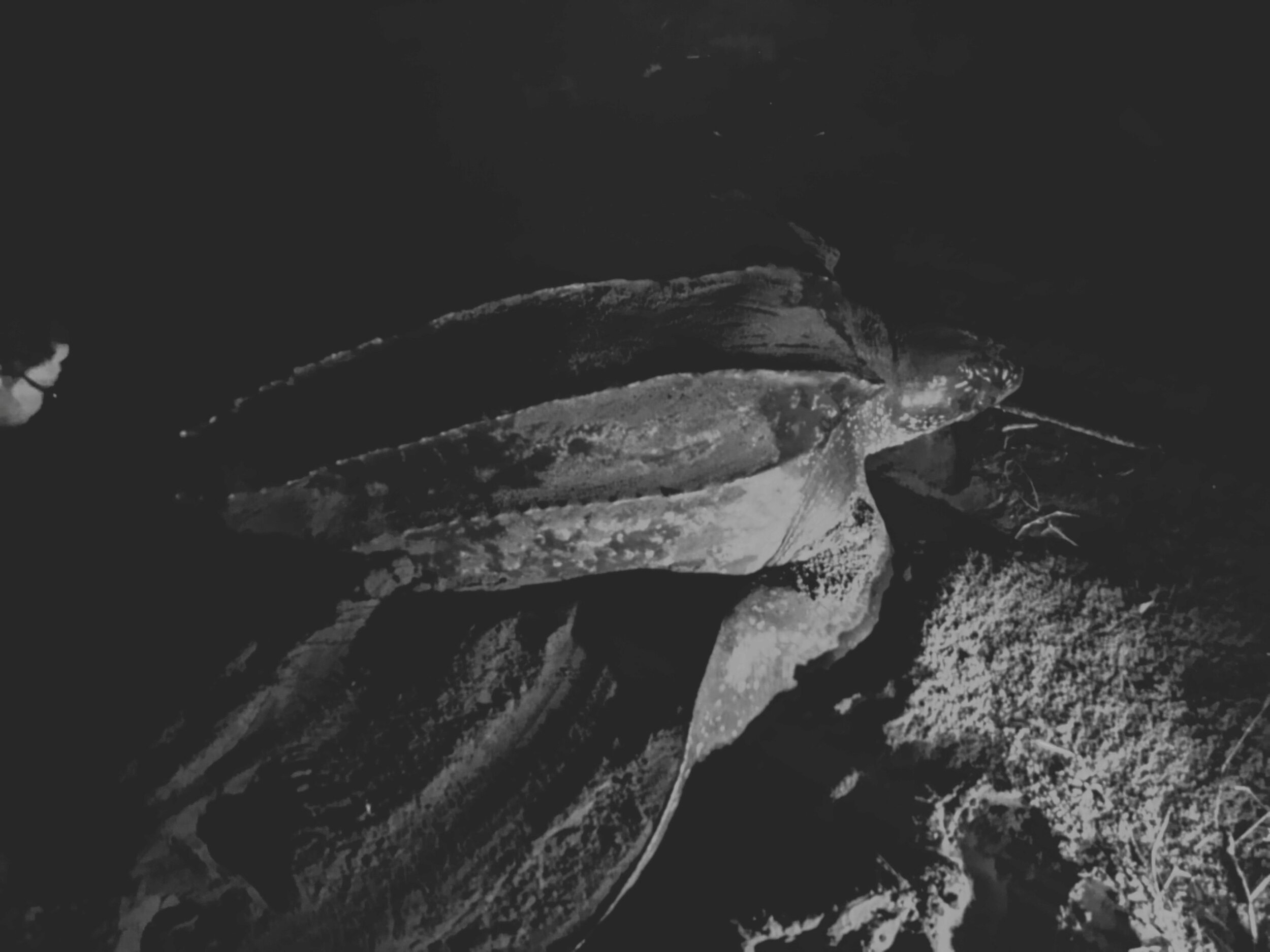
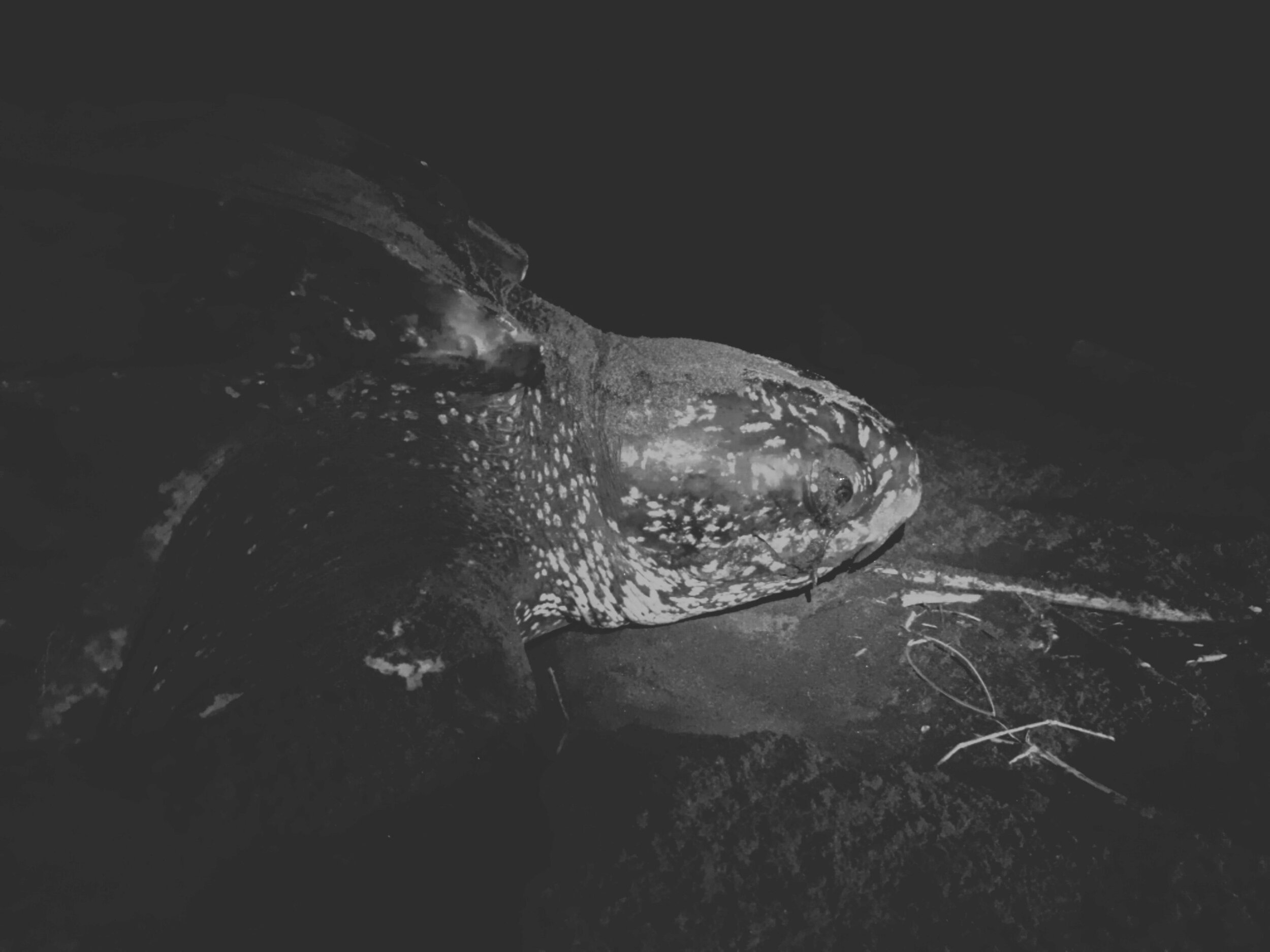
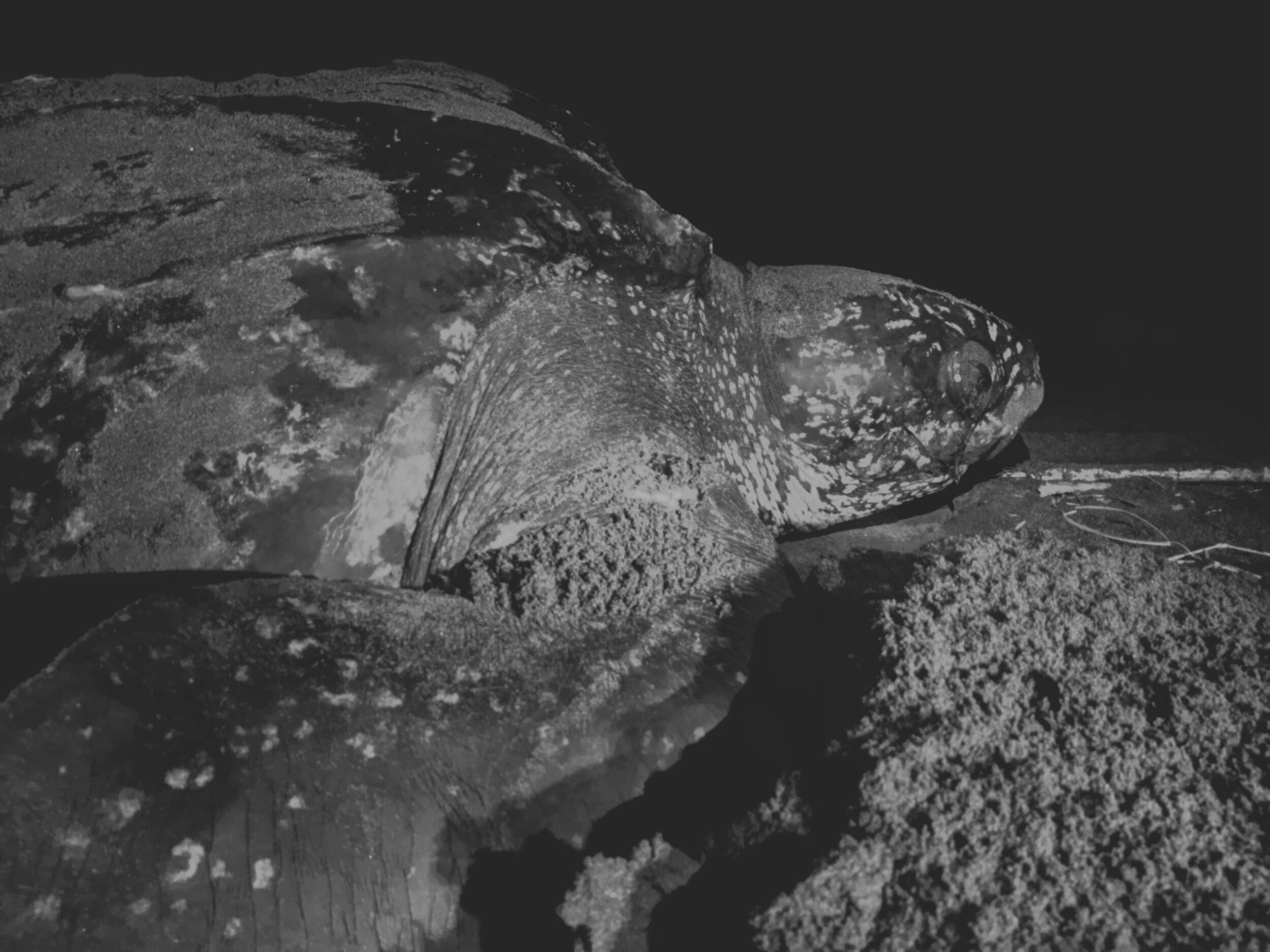
Leatherback turtles are one of nature’s most fascinating animals. The largest turtles and one of the largest reptiles on earth, they can reach more than 6 feet long and 800 lbs. They nest from March to June along the Caribbean coast of Central America.
Location: Soropta Beach, Panama (a Sea Turtle Conservancy project).
Photos: Lulu Muse (using red light, which was edited out, no flash photos taken).
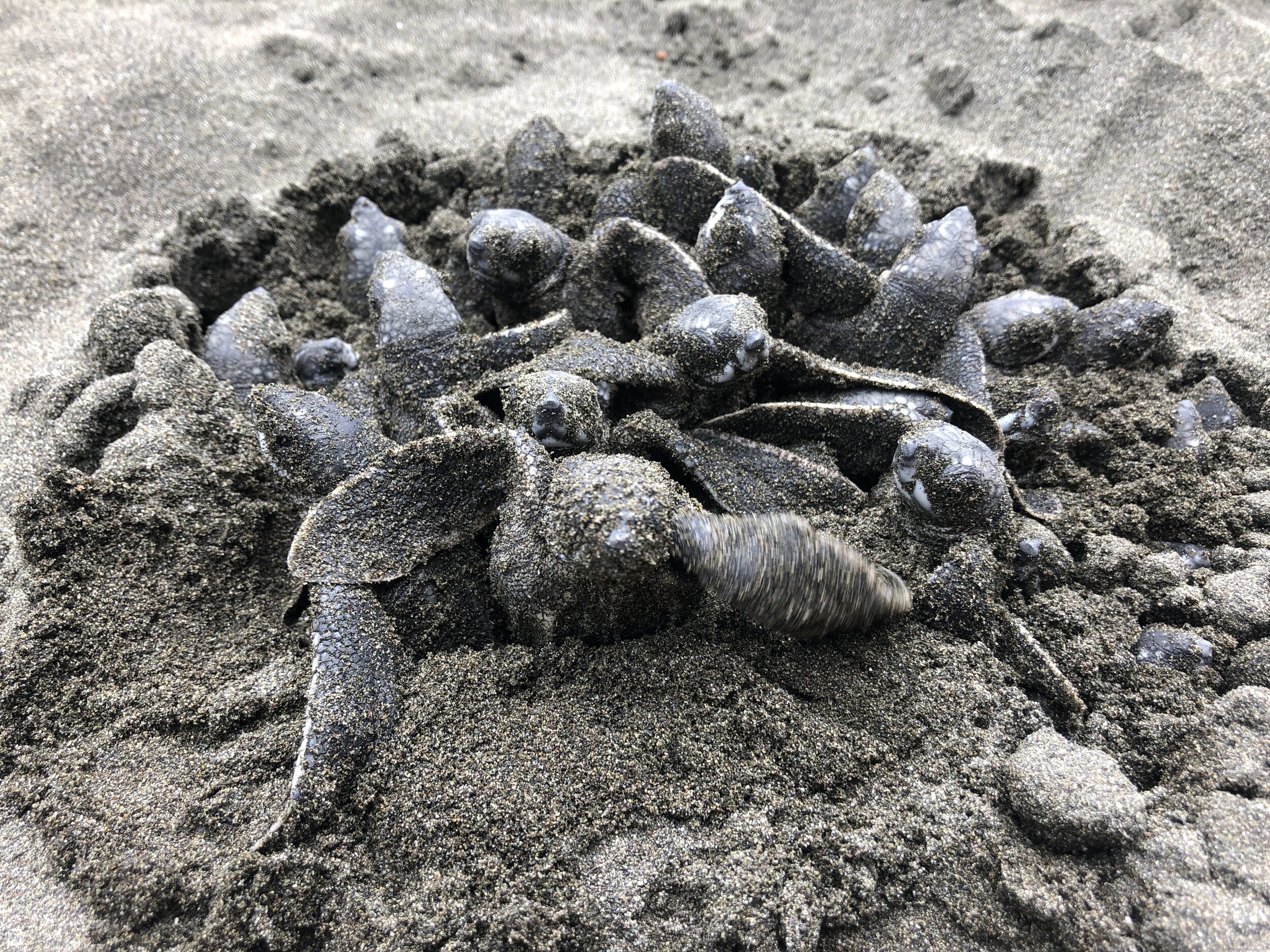
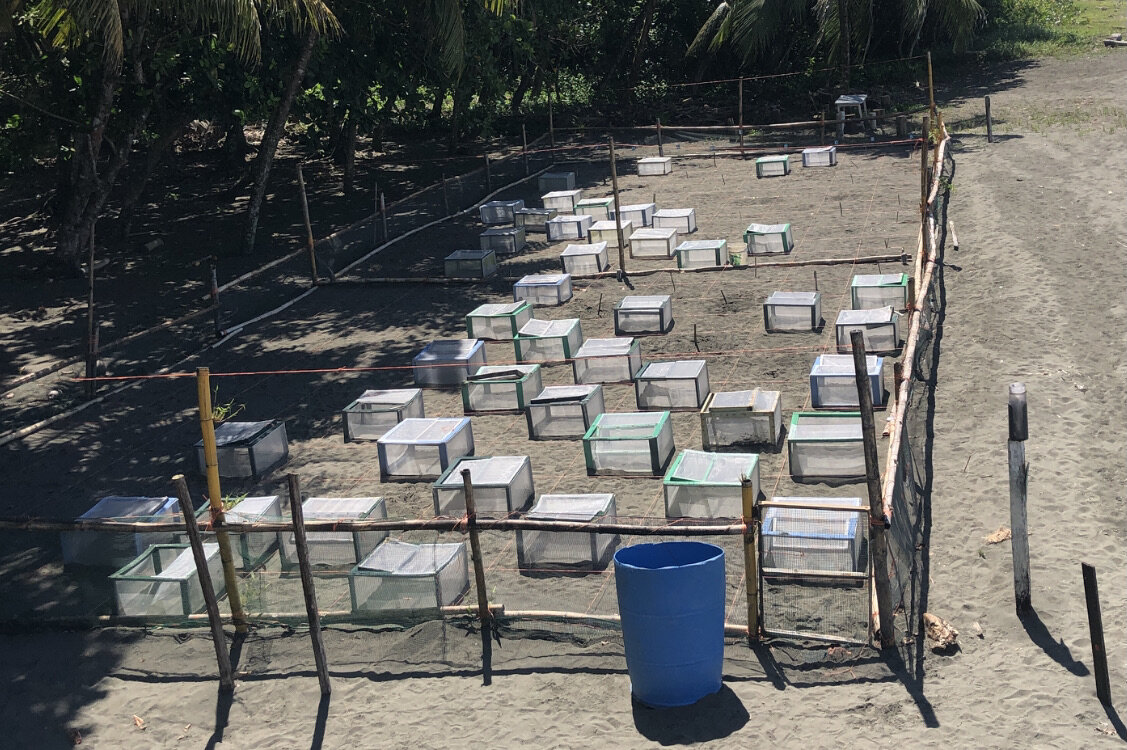
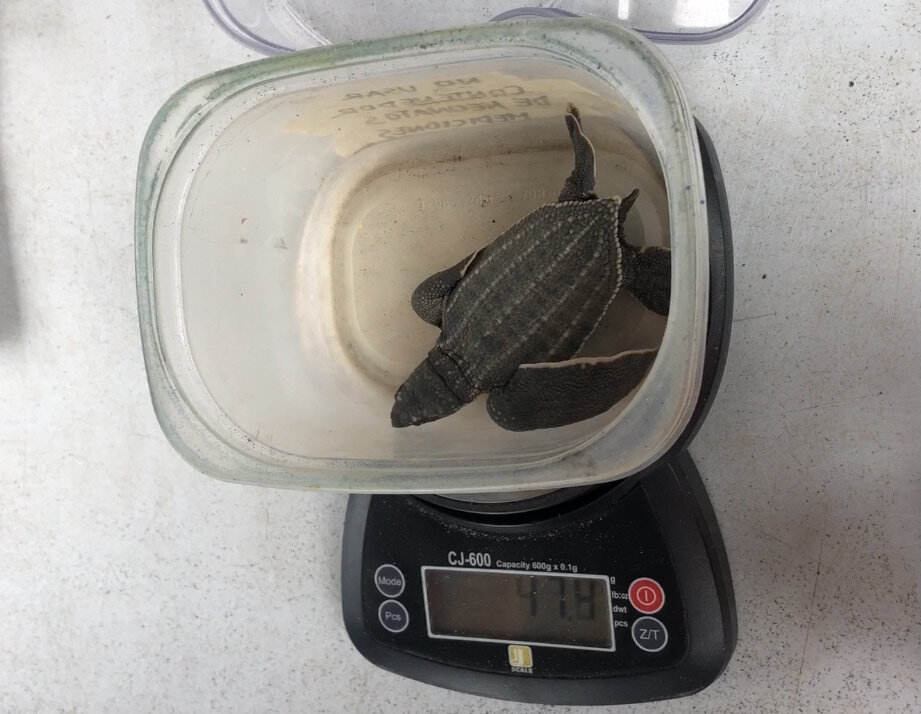
Leatherback hatchlings take around 53 days to hatch from their eggs. Once they do, they will emerge from the nest in a group (called a “boil”) and then head to the water. At the Las Tortugas Research Station, these turtles are watched for safekeeping in a hatchery. Once they hatch, a sample of hatchlings are weighed and measured and then released to the ocean.
Location: Las Tortugas Research Station (Costa Rica)
Photos: Brad Nahill / SEE Turtles
Leo from Latin American Sea Turtles shares with us information about their Pacuare Beach nesting project and hatchery in Costa Rica.
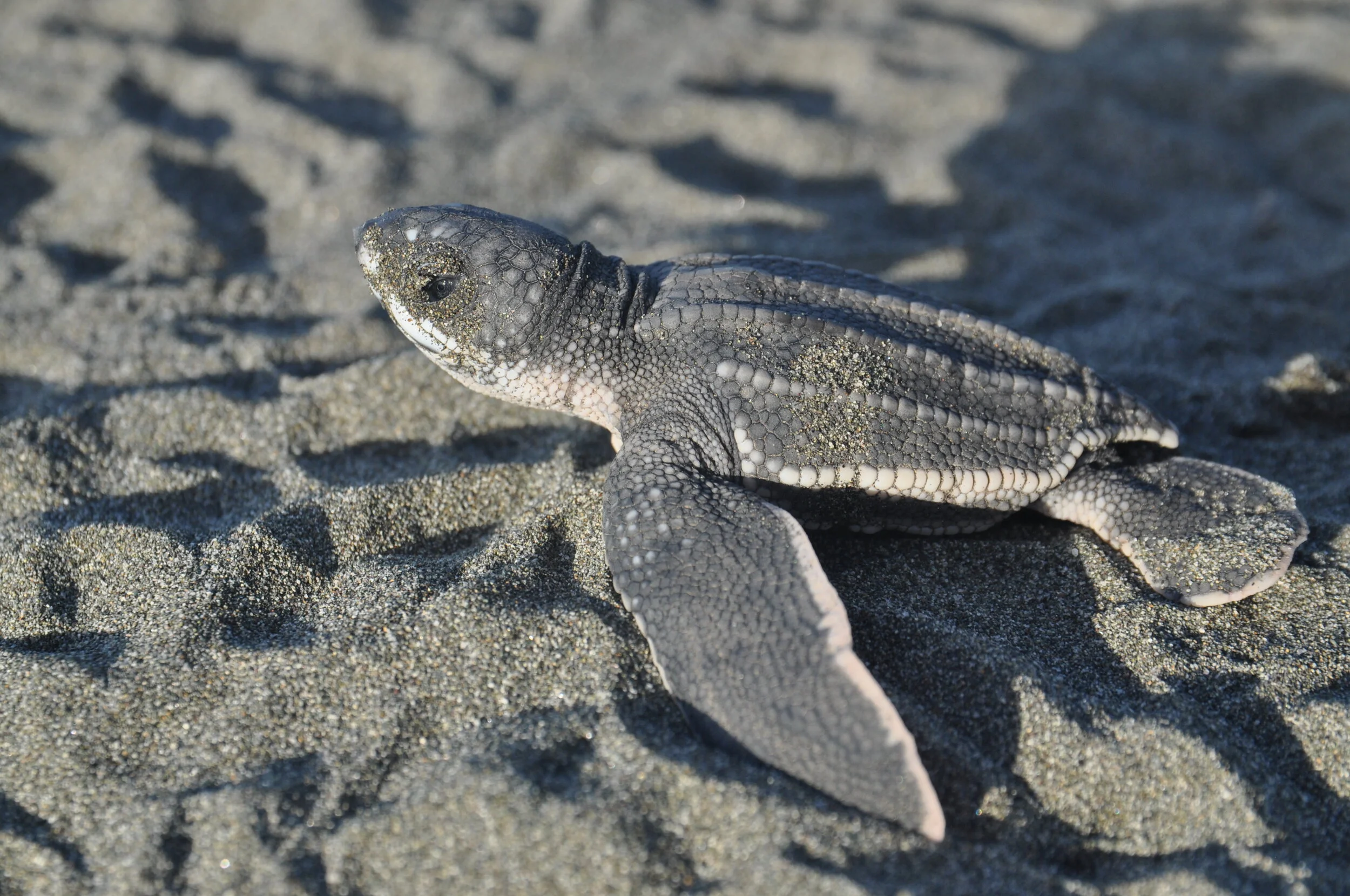
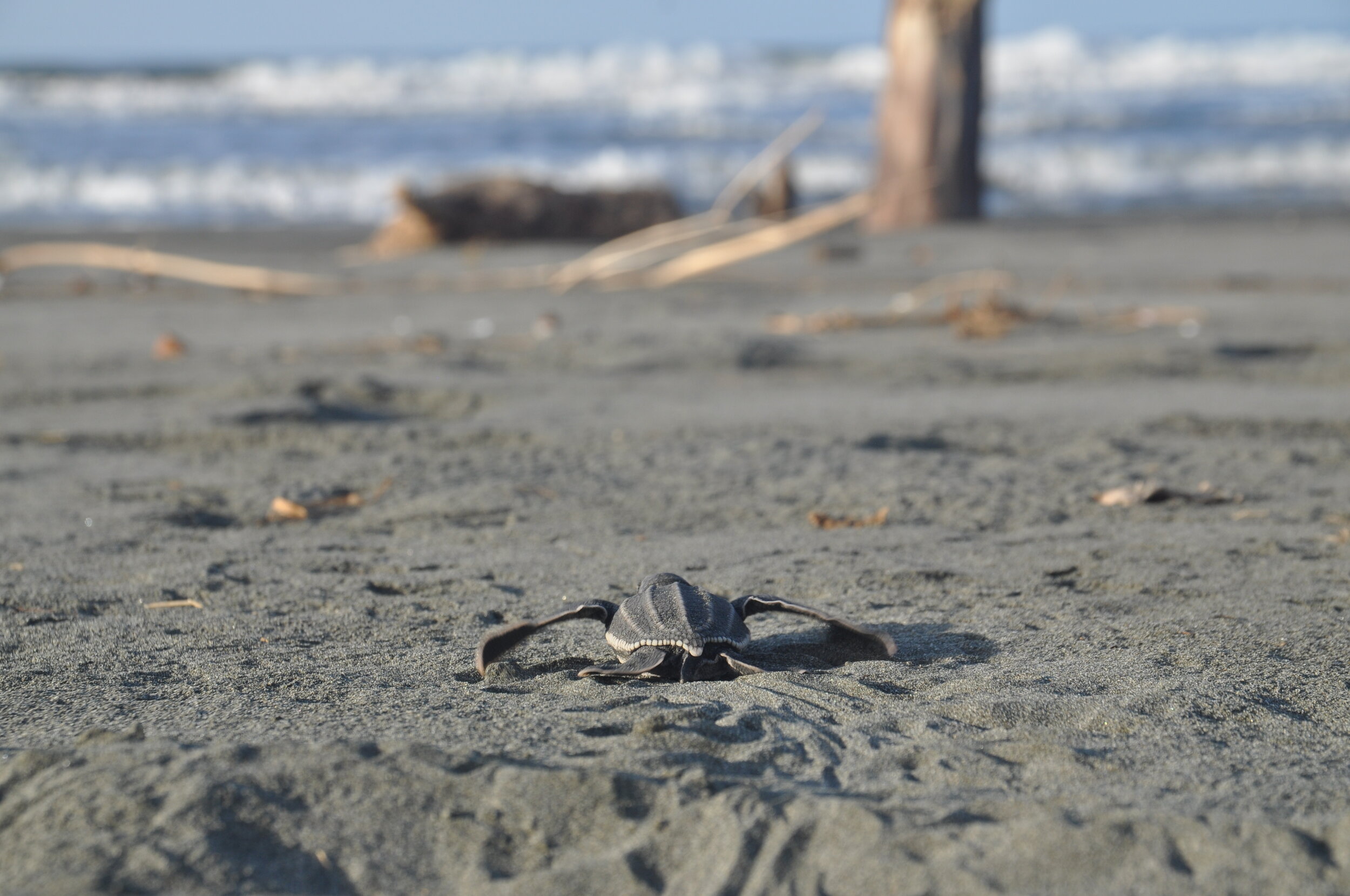
Once a hatchling emerges from the nest, it will make its way to the water, using light, sound, and slope of the beach to find its way. This can be a treacherous journey for hatchlings, navigating through beach vegetation, debris, and holes while avoiding predators like birds and crabs.
Location: Soropta Beach, Panama (Sea Turtle Conservancy)
Photos: Brad Nahill / SEE Turtles
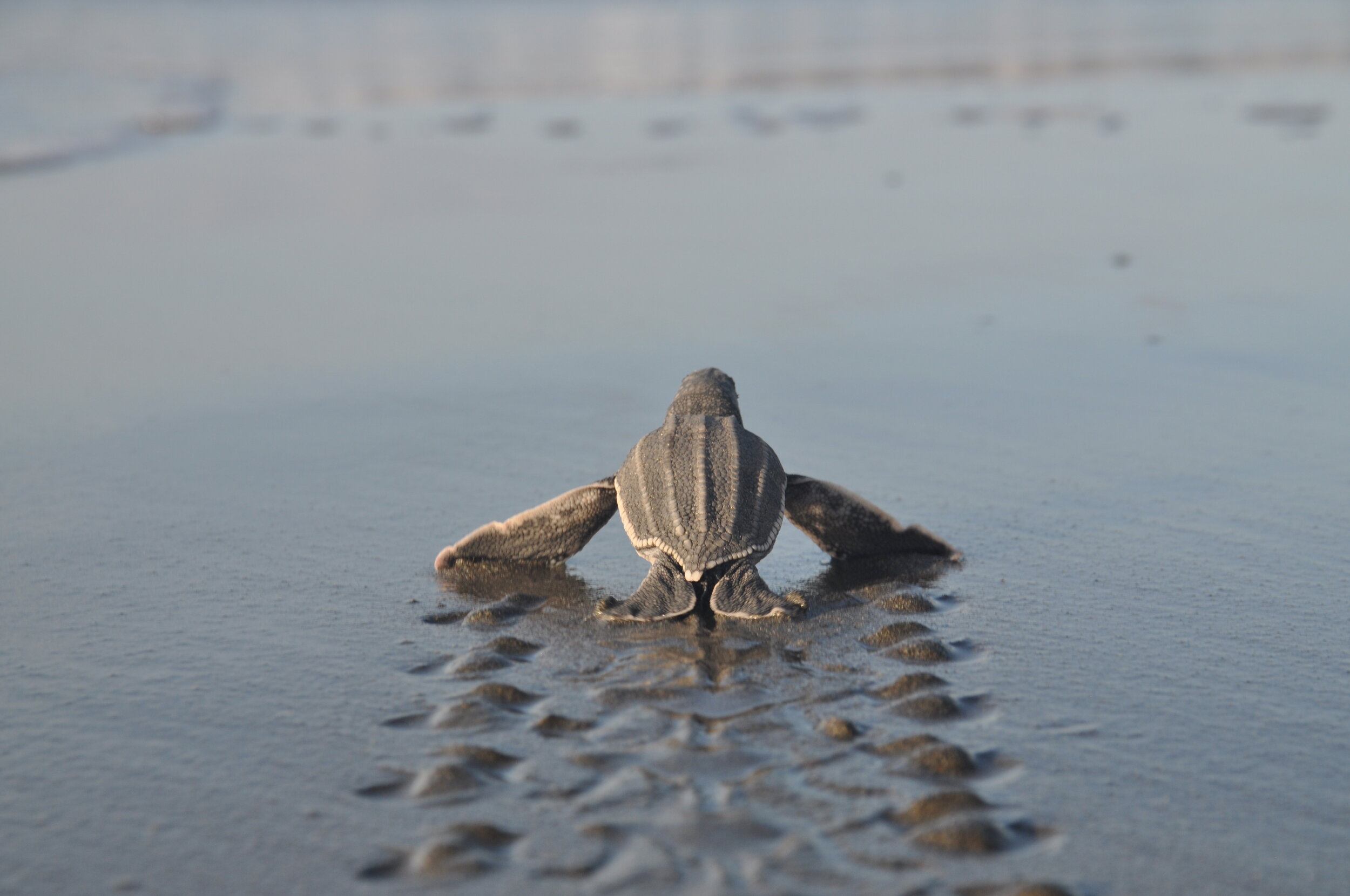
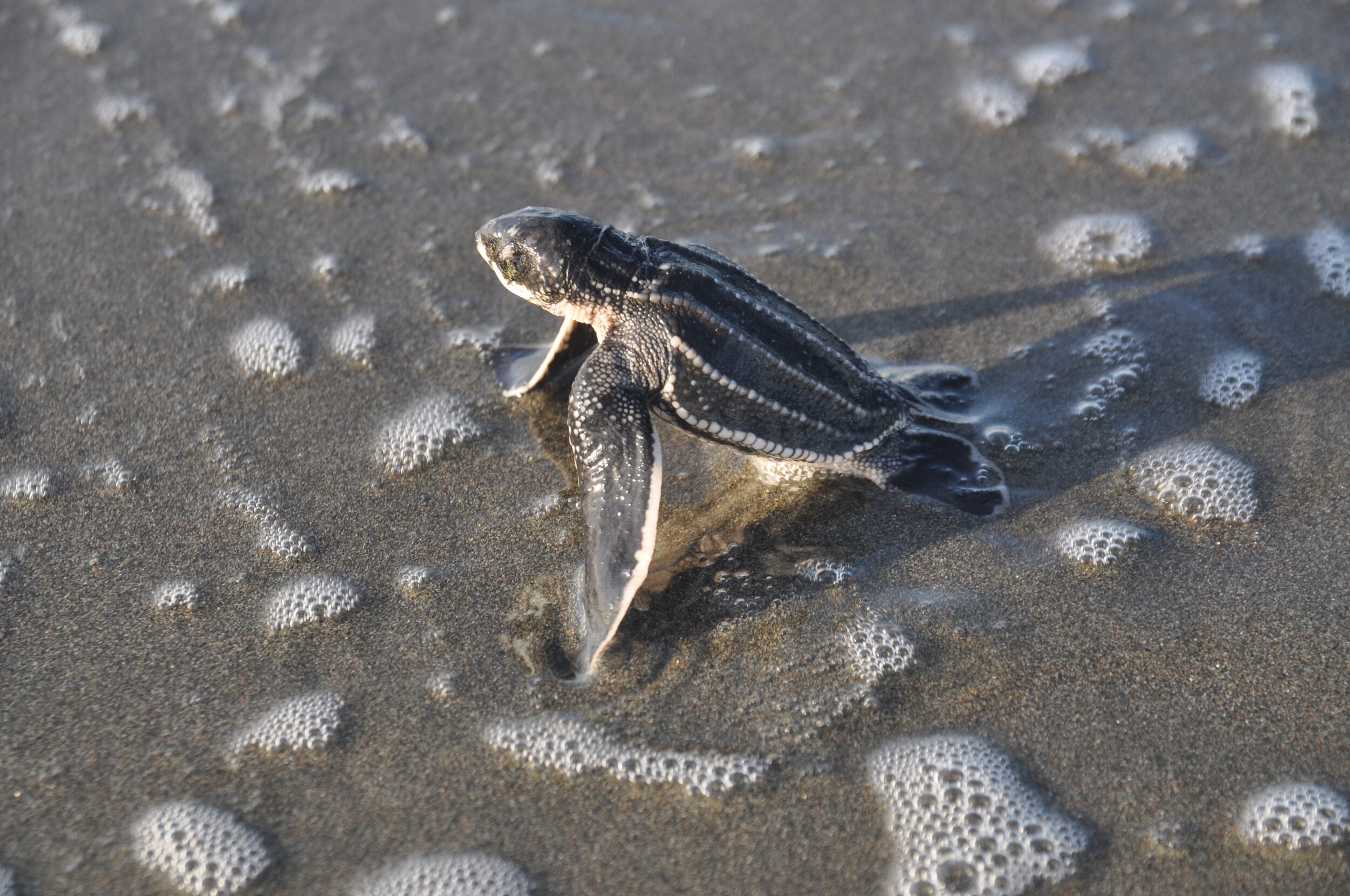
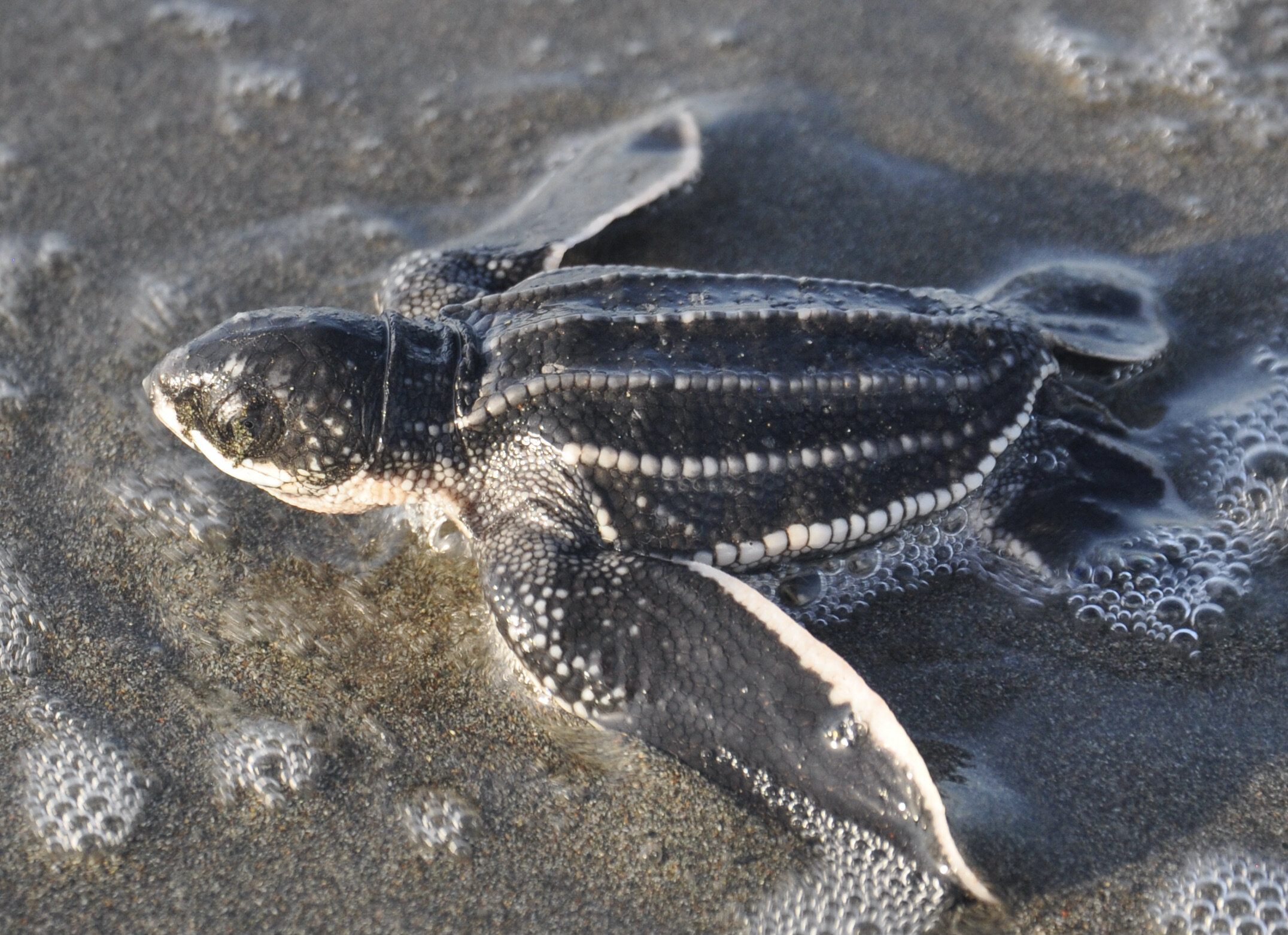
Once a hatchling reaches the water, it has a couple of days of food left from the egg yolk so it can swim without stopping. In the water, the hatchlings need to avoid predators like fish and birds. Where they go from this point is still a mystery, called the “lost years” as researchers are just beginning to be able to track hatchling movements with transmitters.
Location: Soropta Beach, Panama (Sea Turtle Conservancy)
Photos: Brad Nahill / SEE Turtles
Xavier of the Sea Turtle Conservancy excavates a previously hatched nest to examine how many hatchlings survived.
Billion Baby Turtles Update - July 2021
Billion Baby Turtles continues to grow and the project now helps to fund more than 30 different nesting beach conservation programs around the world. Here is an update from some of our current partners.
So far in 2021, we have provided $115,000 in grants to 22 sea turtle conservation organizations around the world and are on pace to provide a record amount of funding this year. Thanks so much to all of the individuals, businesses, students, foundations, and others who have helped this program grow every year since our start!
Jiquilisco Bay, El Salvador (ProCosta)
SEE Turtles has partnered with ProCosta and the Eastern Pacific Hawksbill Initiative (ICAPO) since launching Billion Baby Turtles in 2011, supporting the work at Jiquilisco Bay, one of the most important nesting areas for Eastern Pacific hawksbills in the region. This past season at Jiquilisco Bay, there were 299 hawksbill nests, of which only two were illegally collected. This tremendous effort resulted in more than 18,000 hatchlings reaching the ocean while benefitting 187 local families involved in the conservation work. The great news is that this population continues to grow; of the 85 turtles that ProCosta observed, nearly half (40 turtles) were untagged, meaning that they are likely new nesting turtles.
Hawksbill hatchling from El Salvador (Photo: ProCosta)
This is the tenth year that Billion Baby Turtles has supported this effort; our financial support has helped to save an estimated 111,000 hatchlings since 2011, providing more than US $50,000 in funding. This season, our support helped to save an estimated 10,000 hatchlings.
Learn more about ProCosta here (Facebook).
Paria Gulf, Venezuela (ProVita)
Billion Baby Turtles started supporting this project in 2020 as part of our Sea Turtle Emergency Fund, which helped projects impacted by the pandemic. During the past season, the project had 94 hawksbill nests which produced more than 2,500 hatchlings. Scarcity of fuel and funding reduced the patrolling that was done but with our support, they were able to maintain the rate of illegal collection of nests under 5%.
Hawksbill turtle from Venezuela (Photo: Clemente Balladares)
According to project director Clemente Balladares, Billion Baby Turtles funding helped the project to survive the fuel scarcity and the first difficult months of the pandemic and now the project is paying the best salaries of any turtle project in the country. Billion Baby Turtles started providing funding for this work in 2020 which we estimate to save approximately 15,000 hatchlings (8,000 hatchlings in 2021) with US $7,000 in grants.
Los Brasiles, Nicaragua (Sos Nicaragua)
Sos Nicaragua is a social enterprise that focuses on conservation and sustainable tourism and has worked at Los Brasiles since 2019 to protect three sea turtle species. The main species they protect at this beach is the olive ridley, of which they had 102 nests, producing nearly 9,000 hatchlings. They also in 2020 had one hawksbill and one green turtle nest, releasing 69 and 37 hatchlings respectively from those nests. Illegal collection continues to be a major issue in this area and with limited funds, Sos Nicaragua was only able to monitor one-third of the beach. They registered 109 nests collected illegally, making it clear that the 100+ nests they protected would otherwise likely have been collected as well.
Olive ridley hatchling from Nicaragua (photo: Sos Nicaragua)
This program uses incentive payments for local residents to bring eggs to their hatchery to be guarded until they hatch. Billion Baby Turtles funds provided more than US $1,200 for these payments in 2020, which benefitted 21 local families in four communities, which was valuable income during the pandemic when little other work was available. Billion Baby Turtles has supported this organization since 2017, providing a total of roughly US $9,000, which has helped to save approximately 17,000 hatchlings.
Learn more about Sos Nicaragua here.
Playa Larga, Panama (Sea Turtle Conservancy)
This beach, located in the Bastimentos National Marine Park, is part of one of the most important areas for hawksbill nesting in the world. The Sea Turtle Conservancy, under the management of Drs. Anne & Peter Meylan, has worked with the Ngäbe-Buglé indigenous community since 2003 to study and protect hawksbills nesting on this beach and nearby beaches. In 2020, there were a total of 121 hawksbill nests identified inside and near the park. Due to increased illegal collecting due to the pandemic, one quarter (31) of the nests were taken. Of the remaining nests, an estimated 10,018 hatchlings survived.
Billion Baby Turtles has supported this work since 2019, providing nearly US $20,000 in grants, helping to save an estimated 67,000 hawksbill hatchlings.
Project staff Arcelio with a nesting hawksbill (Photo: Peter & Anne Meylan)
A Tour Of Turtle Projects in Costa Rica & Panama: Part I
Las Tortugas & Pacuare Leatherback Projects
The journey to Costa Rica, other than most people wearing masks, was indistinguishable from pre-pandemic days. Long lines, full flights, annoyed travelers all abounded as I made my way to Costa Rica. Our plan was to get to as many turtle nesting beaches in Costa Rica (and Panama) as we could pack into two weeks, joining our leatherback trip, visiting partners that we support through our Billion Baby Turtles program and checking out sites for new conservation trips.
We started off with dinner at my favorite restaurant in the country, Tin Jo, a pan-Asian restaurant that has been providing a diverse menu for more than 20 years. Joining my companion and I was Luna, a Brazilian student who was heading to Tortuguero National Park to be a research assistant with the Sea Turtle Conservancy for the next six months. Luna was a runner-up of our first Sea Turtle Inclusivity Fund scholarships, winning money to help cover her travel expenses. We learned about her experiences working with sea turtles in her native Brazil and her excitement for working on one of the world’s most famous nesting beaches.
The next morning, our group of travelers met to head out to the Caribbean coast for our Costa Rica Leatherback Turtle conservation trip. Our group was a diverse set of folks ranging from college students to retirees and all were excited to see their first leatherback turtles. On the way, we stopped at Jardin Pierella, an extraordinary oasis of wildlife in the Sarapiqui region. There we saw many species of birds, including the great green macaw, a wildlife success story that had fewer than 50 breeding pairs when I first worked in Costa Rica in 2000 but is now recovering. We also saw aracari’s (a type of toucan), poison dart frogs, sloths, and blue morpho butterflies. On the way out, as a heavy rain fell, we spotted a two-toed sloth making its way quickly (for a sloth) along a power line (which can be dangerous to wildlife).
Aracari (photo by @lulumuse)
Red-eyed tree frog (photo by @lulumuse)
From there, we met a boat to take us the final leg of our trip to the Las Tortugas Station on the northern Caribbean coast. Our group did not have to wait long before seeing their first leatherbacks after we arrived. As we moved our bags from the boat to the rooms, we were alerted by project staff that some hatchlings had emerged. We quickly made our way to the beach to help measure a sampling of the baby leatherbacks and then release them to the water. After a break and dinner, the group readied to head out to the beach dressed in dark clothes to walk the nesting beach looking for leatherbacks.
Leatherback hatchling
Our group split into two to divide up the beach and on our way to the further section, we came across our first adult leatherback. “Oh my god,” exclaimed one traveler upon seeing the giant (though small for the species) turtle digging its nest. This one was 140 centimeters (about 4 ½ feet) long, one of the smallest turtles recorded at Las Tortugas this season (though that length does not include their long heads). Several group members helped with the research, holding its back flipper to better access the eggs, writing down the data, measuring the turtle, and bringing the eggs to the hatchery for safekeeping.
A second leatherback followed later that evening, a great start for the first two nights at this point in the season (which starts in March and peaks in April/May.) On the way back to the station, we found a hawksbill nest, which the station biologist Tamara expertly found, even though I had been skeptical the turtle had laid her clutch. All of the nests were safely transported by project researchers to the hatchery for safekeeping.
Nesting leatherback turtle (photo by @lulumuse)
The next day, the group’s first full day at the station, just happened to be World Oceans Day and the official start of Sea Turtle Week! As the coordinating group for the week, it was great fun to be in the field with the turtles during the third year we worked on it. The week was a tremendous success with more than 170 participating organizations and 10 million people reached through social media, both records by a large margin.
We celebrated with a great presentation on turtles by the project biologist Tamara, followed by some nest excavations where the old nests are dug up to look for stragglers and collect data on the eggs that did not hatch. Also, puppies! One of the station’s dogs had puppies whose eyes were just beginning to open. The group also took a walk in the nearby forest, seeing two species of monkeys (howlers and spider monkeys), and saw a three-toed sloth in a tree by the station. That evening, as the group was about to head out to patrol, we were alerted of a turtle nesting right in front of the station, perfect for one of our group who was not able to complete the longer patrols. Las Tortugas is truly a heaven for animals.
The next morning, our group participated in a beach clean-up, helping to clear the beach of both natural debris (which can prevent hatchlings from reaching the water) and trash that washes up from around the world. Plastic waste can be a threat to sea turtles in many ways and by helping keep the beach clean, we improve the chances of survival for the hatchlings.
That afternoon, my companion and I left on a boat to visit another leatherback beach further north along the Caribbean coast, the Pacuare Station run by Latin American Sea Turtles (LAST). Their president Didiher Chacon, my former boss and mentor and a leading turtle conservationist in the country, and I discussed our shared work on the tortoiseshell trade and possibilities to support new nesting beaches in the country. Later we met the staff, including the philosopher poet Leo, a fascinating and inspirational activist who has worked across the region on conservation and social issues (see video below).
We headed out for a patrol that evening on this pretty unique stretch of beach. Unlike many other nesting beaches, Pacuare is not in a protected area and the nests are actively illegally collected by some local residents. To keep peace with the community, since LAST does not have law enforcement power, there is an unwritten agreement with egg collectors that whoever arrives to the turtle first gets the eggs. The rate of nests illegally collected varies from year to year but this year it has been more than 50%. The pandemic only worsened the situation for the turtles, with fewer people out patrolling and more people in need of food and income.
Our run of luck continued with a nesting turtle shortly into the patrol. This was another smaller leatherback, one relatively fast in comparison for its speed during the nesting process. We were treated to both slaps from the turtles long front flippers as we tried to measure her as well as some bits of sand in the eyes and mouth as she camouflaged her nest. After taking her eggs to the hatchery, we crashed for the night to prepare for a long day of travel the next day.
This morning we headed down the canal that runs parallel to the Caribbean coast from Tortuguero to Moin. A beautiful ride included the wonderful scent of Ylang Ylang (where Chanel No. 5 comes from) as well as birds, monkeys, and more. We pulled into Moin and met our colleagues from Latin American Sea Turtles and visited their hatchery across from the giant new port that brings in goods to the country. LAST has patrolled this long stretch of beach going north since 2015, which was previously open to illegal egg collecting. Due to their hard work, this beach now releases more than 10,000 hatchlings per year.
From there we headed south for a couple of days of rest in Puerto Viejo, along the southern Caribbean coast. Though this area has become much more upscale than 20 years ago when I worked on Playa Negra to the north, the area retains its laid-back Caribbean vibe. One of my jobs 20 years ago was to scout the local artisan stands on the lookout for tortoiseshell products, which I fortunately never found. So it was with a bit of déjà vu that we visited the beachfront stands testing a new app that we are developing that will recognize these products from photos. Other than one product that we were told was real tortoiseshell (though we believed it was not real), the area remains tortoiseshell-free to our delight.
Stay tuned for Part 2 coming soon!
What Is It Like To Work With Sea Turtles?
After I graduated from college with a degree in environmental economics, I knew that I needed some real-world experience. I’ve long had a fascination with Latin America so I searched for conservation projects in that region where I could volunteer my time and learn. I had no special connection to sea turtles or background in biology but most of what I found available was volunteer programs working on nesting beaches. These turtle projects need a lot of help to cover long stretches of beach every night, along with working in hatcheries, educational programs, beach cleanups, and research.
So that’s what I chose but back then, I had no idea this decision would guide my career for the next twenty years. Those first nights on dark beaches working with giant leatherbacks taught me many lessons, such as interacting with local residents, braving weather and exhaustion to complete the work, and working in teams for a shared goal. It has now been a long time since I walked the beach every night but those lessons stay with me and were the reason I wanted to bring together people from across this field to share their experiences and lessons they learned.
Brad being sufficiently impressed by a leatherback nesting in Trinidad
Working with these extraordinary marine reptiles is much more than walking miles every night on a nesting beach. Our new book, Sea Turtle Research and Conservation, provides real world examples of a variety of facets of this field. We look at managing tourism in places like Costa Rica, Grenada, and Sri Lanka, how one group in Curacao is turning plastic waste from a threat to sea turtles into a way to protect them, and what it’s like to work in a community that initially is not in favor of protecting sea turtles.
We cover some of the most challenging aspects of sea turtle research and conservation. One chapter looks at ways that conservationists are working with fishermen to find ways that keep turtles out of nets while not costing fishermen their livelihoods. Another chapter has great examples of how advocates are addressing the trade in sea turtles and their parts in Colombia, Africa, and globally. Finally, we have practical advice for practitioners and students in this field on how to raise funds for this work and combining new technologies with old fashioned observation.
This book is one way I am giving back to all those mentors who helped me learn, grow, and thrive in this field. I hope that my current and future colleagues find these experiences useful in their work, now and in the future.
The Few, The Proud, The Black and Brown in Marine Science
With a Google search you will see that the marine field is lacking diversity. The first page presents a similar view that you will find in the marine science field; it’s full of white faces. In order to see the Black and Brown faces of marine scientists you must search through many pages or specifically search black or brown marine scientists. We are just like male adult sea turtles, often forgotten about until we make our presence. Female sea turtles get a lot of attention since they are more easily accessible for studies as they return ashore to nest. Whereas male sea turtles never return to land unless they are sick or injured. Continue reading below as I show similarities between Black, Indigenous and people of color (BIPOC) marine scientists and sea turtles, in our journey to survive to meaningful careers for us scientists and adulthood and reproducing for sea turtles.
1 in 1,000 is the estimated number of sea turtle hatchlings that will survive to adulthood. I don’t know the numbers of Black and Brown scientists that do not make it to their dream career, but I have heard countless stories of those who stopped before they reached the finish line. Like sea turtles, there are several reasons why Black and Brown scientists do not make it to “adulthood” in this field, reasons like: artificial lights, beach debris and depressions, and predators.
Artificial lights can be disorienting to freshly emerged hatchlings, instead of heading toward the sea by moonlight they travel further inland towards the lights from condos, restaurants, and other sources of unnatural lights. In the same way minorities in marine science are drawn to institutions and other programs with the promise of success and job placement; instead we get lackluster programs that use us as diversity photo opps, plastering us on posters and the website without caring whether we succeed or not and if our needs are being met. These institutions and advisors boast about their diverse programs and an abundant of opportunities only to leave you trapped in a limited resource program that is two people removed from being diverse and you’re the new face of the “diversity” of the program, with the hopes that your presence will bring more diverse talents.
Beach debris and depressions like tires tracks, sand castles holes, and footprints are obstacles that hinder sea turtles success in reaching the ocean, in the same way minority scientists have obstacles of our own that hinder us from successfully entering and staying in the marine field like: low pay and pay to work initiatives and unintentional gatekeeping by seemingly word of mouth funding opportunities.
There are already a limited number of marine positions available, and many times these positions go to individuals that already have experiences. Many times, these opportunities to gain the experience are low paying, no pay at all, or you must pay to gain the experience. Now couple in the life experiences that many Black and Brown Individuals have, like being first generation students, coming from lower economic status families, having to care for younger siblings or grandparents. They do not have the financial resources and opportunities that their non BIPOC counterparts have to take a low or nonpaying opportunity to gain experience in their field. Paying to work is out of the question altogether for many of these scientists, quitting a summer job to probably pay more than you would have made that summer is highly frowned upon by family and many times unfeasible.
While there are many sub-par opportunities like this out here, there are plenty of other well-funded opportunities that are available to all who have hopes of being marine scientist. Some of these opportunities are truly great and can really spearhead a career in marine sciences; the only problem is that many of these opportunities are unintentionally gatekept. The National Oceanic and Atmospheric Administration (NOAA) has plenty of great funding opportunities available for students like: The Office of Ocean Exploration and Research Explorer-in-Training Program, The Research Experiences for Undergraduates in Marine and Estuarine Science, and The John A. Knauss Marine Policy Fellowship amongst other scholarships and internships. Even though they have these great opportunities year after year, they are awarded to cohorts that lack diversity.
The reason is that though the information is available it is not widely made known. The university I attended in undergrad, and where I currently attend as a graduate student has partnered with NOAA numerous times throughout the years and have had many students who received funding and or fellowships from NOAA. I’ve even worked with NOAA employees on many different occasions over my professional career. But it was not until this year when I returned to my university that I learned about these great opportunities available form current students who were selected as fellows for the program, and a seminar that was put on by a NOAA Sea Grant employee.
Predators pluck off hatchlings either by them digging into the nest or predating on hatchlings as they are making their way to the sea. Minority students are predated by advisors who promise funding, attractive opportunities, and resources for those who are coming with funding. Some of these predators will befriend you and welcome you into the lab not truly caring if you succeed or not. They’ll use the funding you came with to fund their work and other advisors will happily fund you and get you into their lab, but they turn out to be horrible advisors many times condemning you for work they either never showed you the correct way to do it. Or you had to figure it on your own because they make you seem like you’re a burden when you ask for help.
These same advisors will hold it over your head that they gave you a position, so you owe them. Many minority scientists never publish or share their work out of fear of retribution from these predators. So even though it’s something you have always been passionate about, it’s better for you to cut ties and go in a different direction for your sanity than to continue dealing with the lack of support, behavior of these advisors. Other advisors are cordial and show support and glorify you to your face, but behind closed doors to colleagues and other students they bash you and make statements like they are surprised you made it this far with your lack of skills or question if the work you have published is actually yours and not the work of one your white classmates. These predatory advisors seem to seek out minority students because many of us are first generation students or know that we are less likely to report their behavior out of fear of backlash or they know from experience that they usually get a slap on the wrist if any discipline at all. The student is then either forced to find a new program or drop out of school completely due to the repercussions of sounding the alarm.
Now having survived the obstacles as students we enter in the career field knowing is not all rainbows and butterflies. Just like adult sea turtles we still must deal with environmental hazards. For sea turtles that’s boat strikes, fishing gear, and other human-caused hazards and naturally occurring threats. Us BIPOCs enter the field only to be entangled and battered by hostile or exhausting work environments, having to continue to fight and prove our worth collectively and as individuals.
As an African American male I have had my share of difficult work environments, but still I have the advantage of being a male over my fellow scientists that identify as women. The marine field, especially the fisheries field, can be a Good ol’ Boys Club with sexist comments and beliefs that women can’t do the same job or don’t belong on a boat full of men for various reasons that are majorly made up by men. I know for fact that every women marine scientist, especially the BIPOCs, deserve to be in this field without the continued harassment and having to prove that they can physically and mentally handle the job as well as prove their knowledge on their study species.
We may all be people of color, but we do not know each other, and we do not speak for everyone in our race. Just like each Kemp’s ridley sea turtle has different characteristics and needs from leatherbacks, I have a different needs and experiences from the black individual across from me. It is tiring for us to be seen as the all-knowing individual on everything for our race.
Being a BIPOC in a field that is lacking in diversity is draining. Sometimes that drainage extends to conferences and events where you think you will finally have the chance to meet and interact with others in your field who are also BIPOCs. A needed interaction where you can talk about the good and bad of your field and offer encouragement to your fellow BIPOC counterparts, only to expend even more energy explaining to non-POC counterparts about being an ally from the sideline and letting BIPOCs have that moment of solitude and a safe space for discussion.
Lastly it's exhausting to be one of the few individuals who looks like you in your field. It's a constant feeling and telling yourself you can't afford to make a mistake or quit because you’re an example for all the other Black people to follow you. Even if you are at your limit you hold on to that glimmer of hope that things will get better, because you don’t want to let anyone down and make Black people look bad.
While we as minority scientists continue to face many challenges throughout our career, we continue to show our resilience. Just like sea turtles, we started from the bottom and dug our way out, navigated over rough terrain, through obstacles, and escaped predators so that we can THRIVE!! After all that we have been through we give our All in the field, office, and lab. We foster relationships with younger minority scientists. We have transformed from the sea turtle hatchling that must overcome obstacles to the Biologist that are now ensuring hatchlings (the next generation of BIPOC scientists) have an even playing field, increasing their survival and further diversifying this field. Black and Brown Marine Scientists, we may be few but we are outchea (out here).
Learn more and participate in Black In Marine Science week here.
Alex Troutman is a co-founder of BlackInMarineScience Week and a graduate student at Georgia Southern University. Follow him on Twitter @n8ture_al


